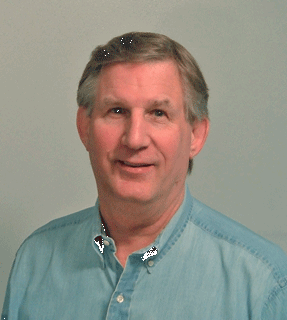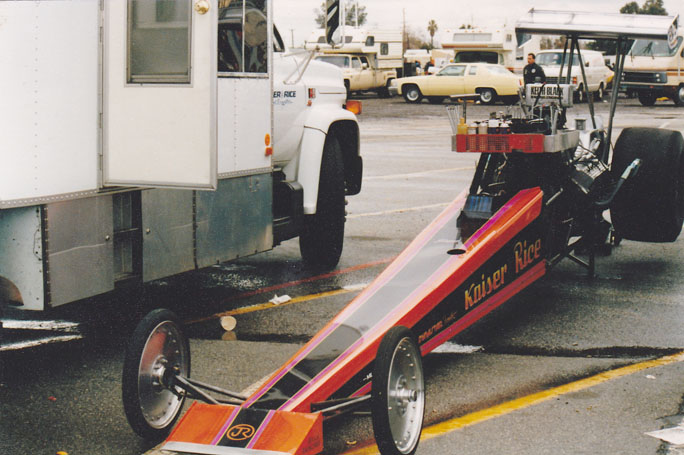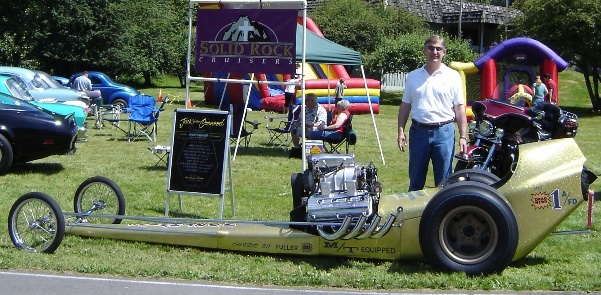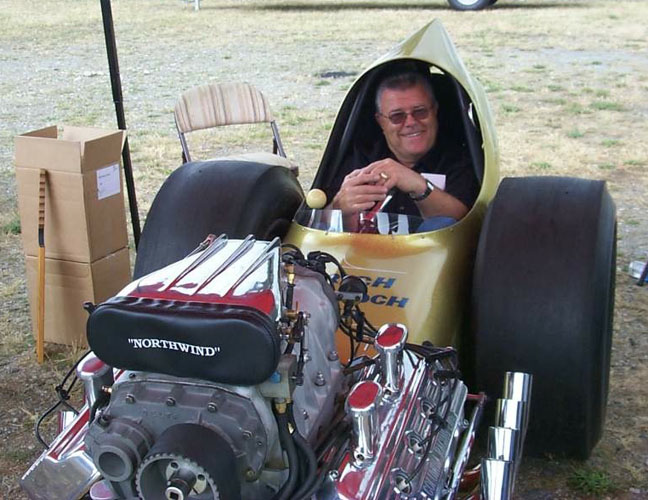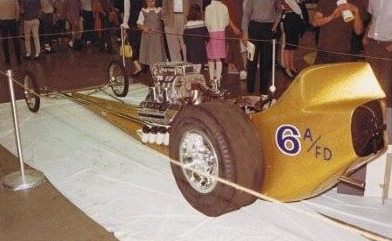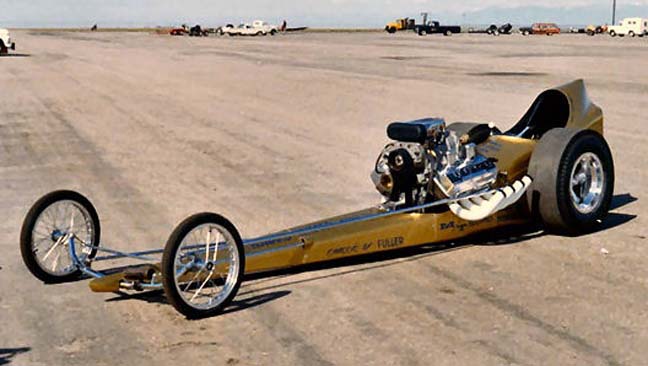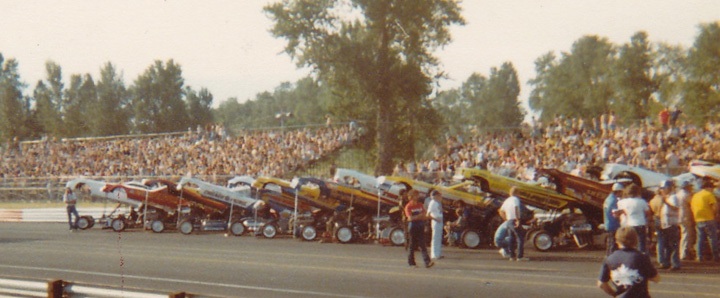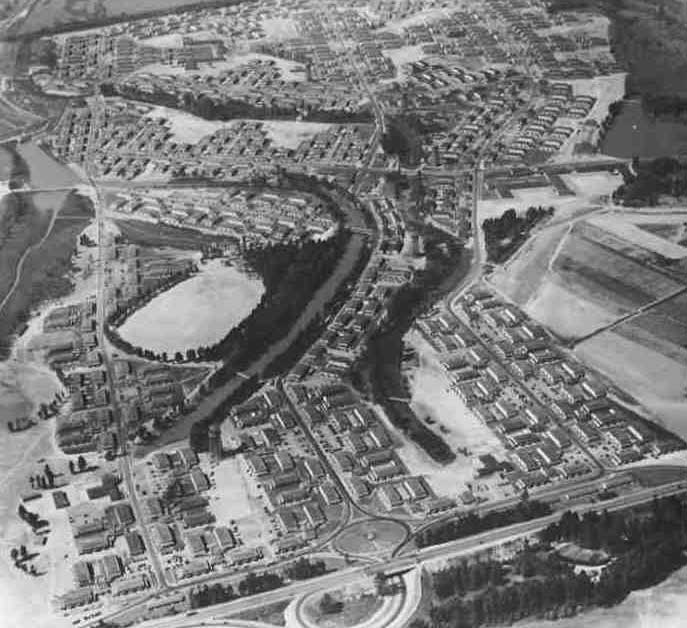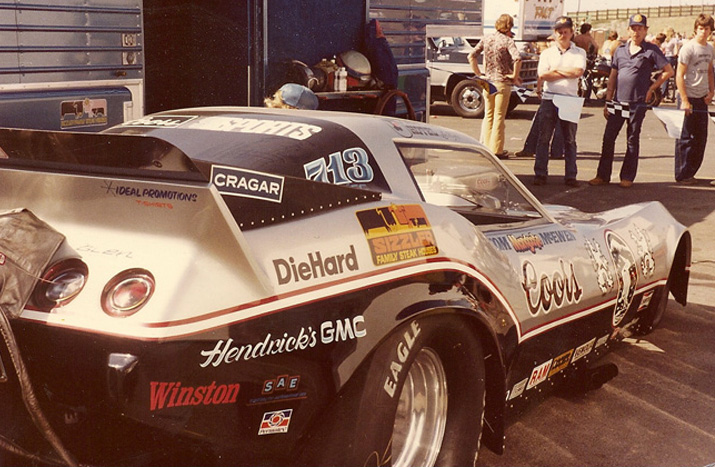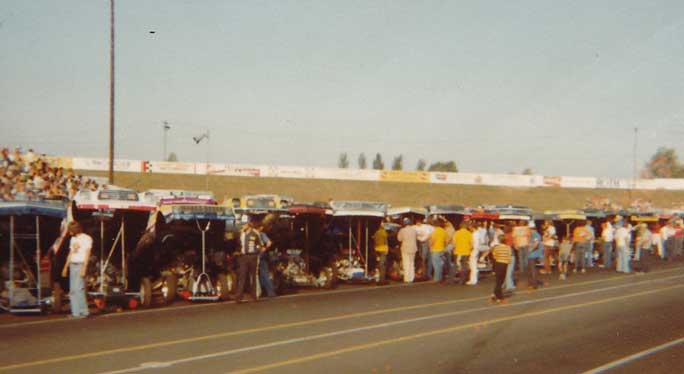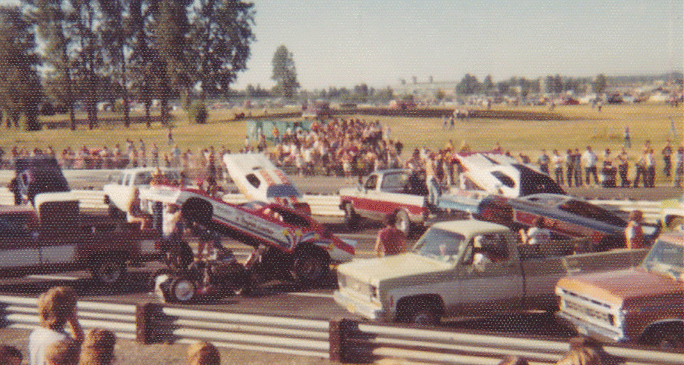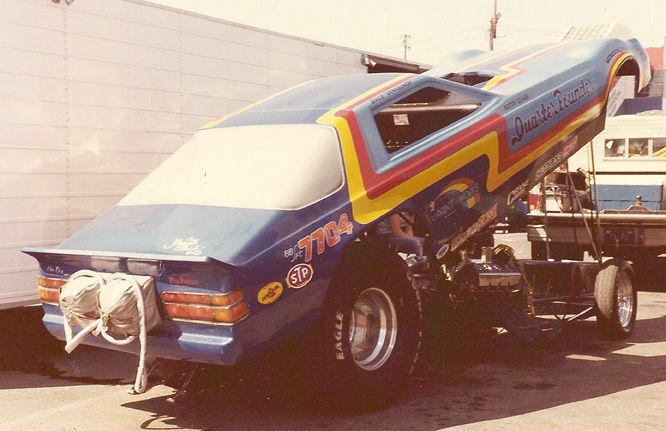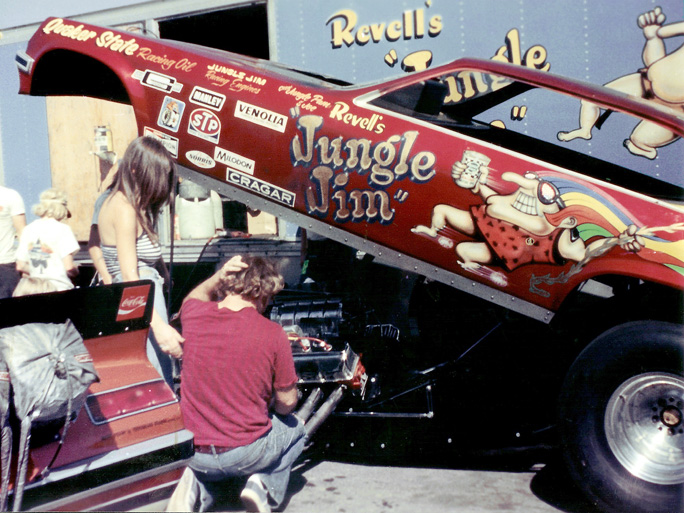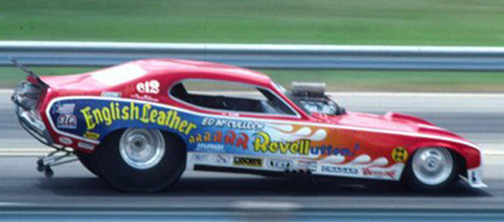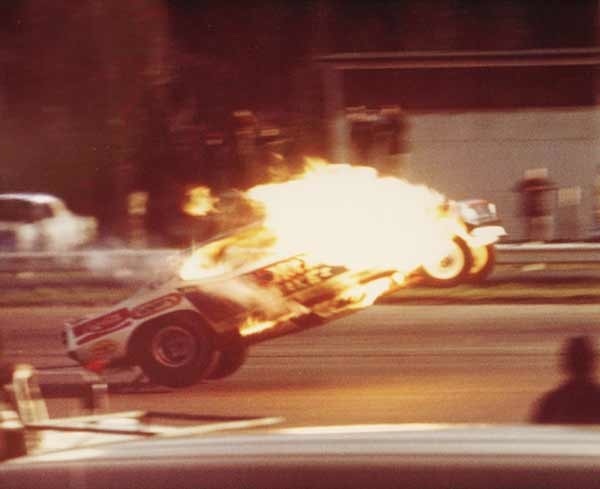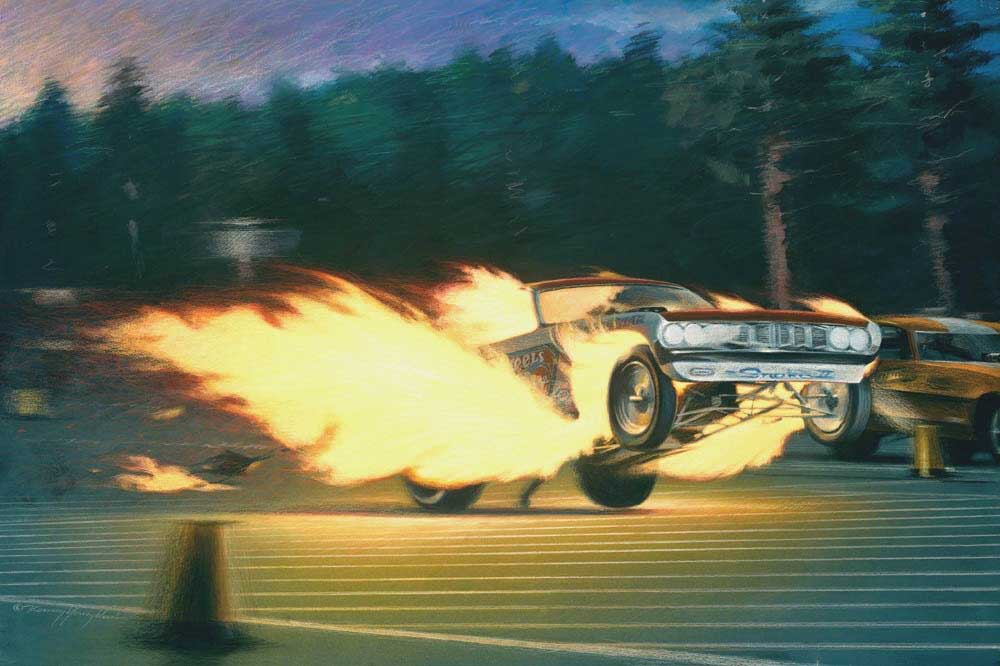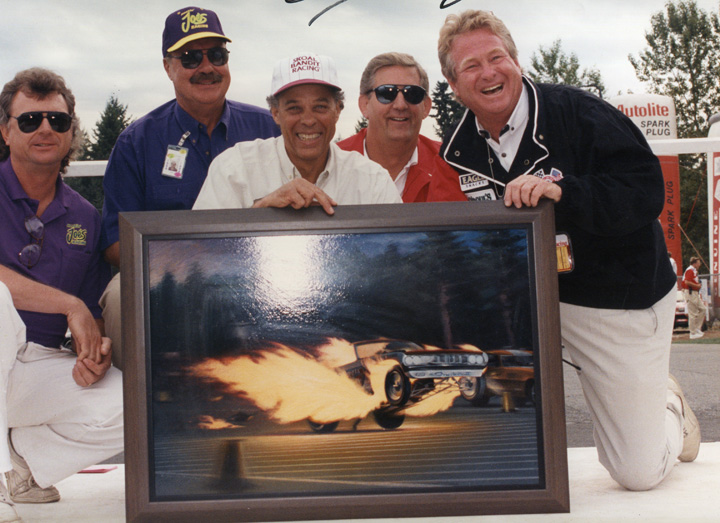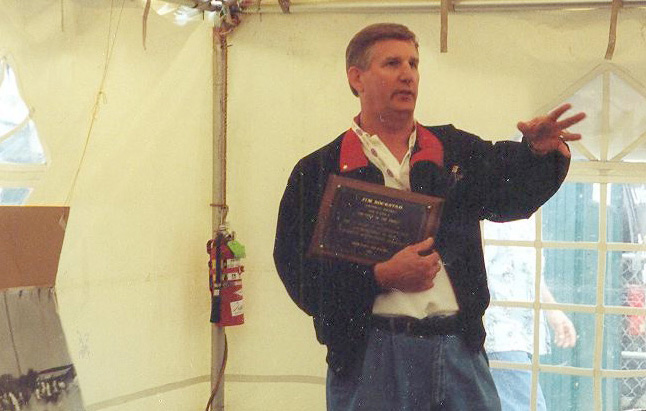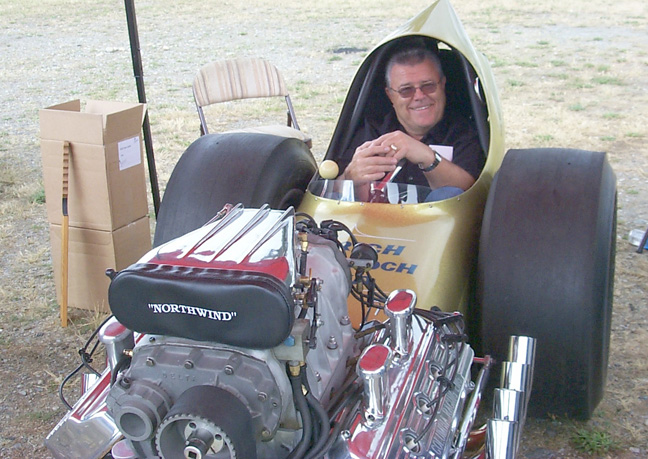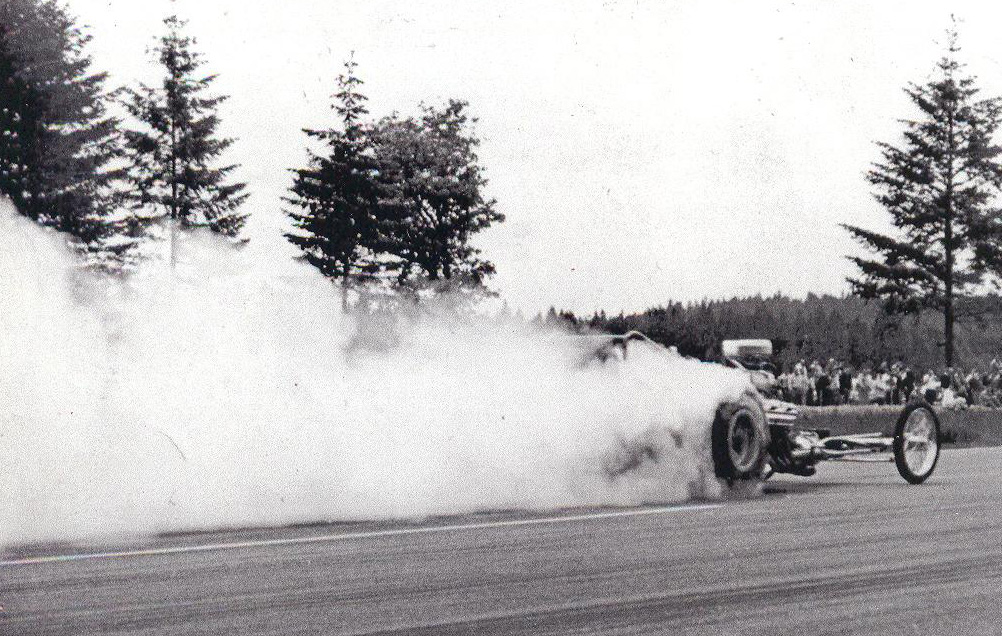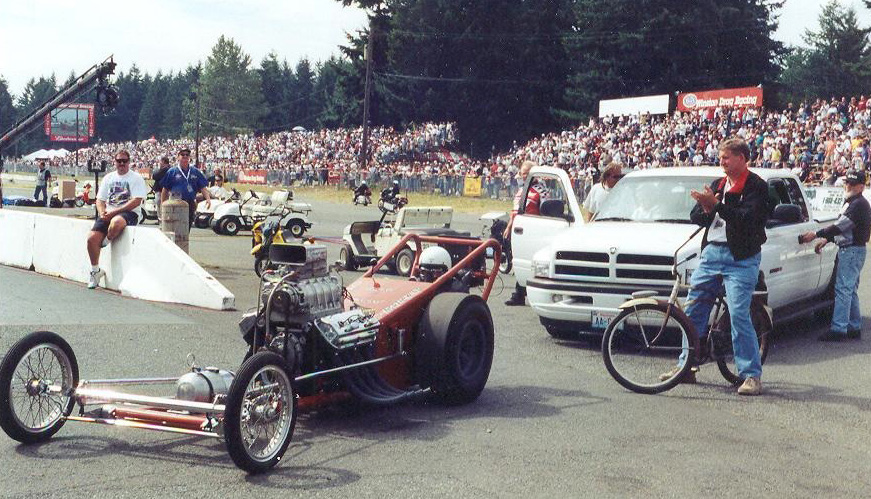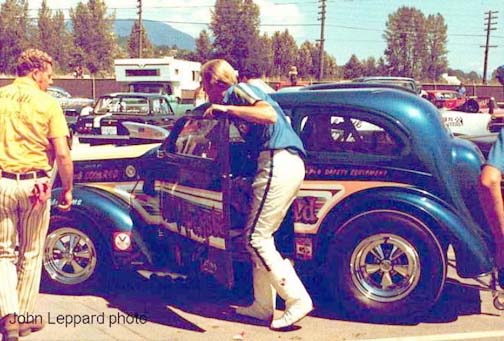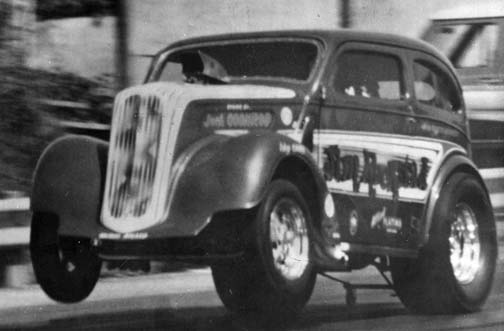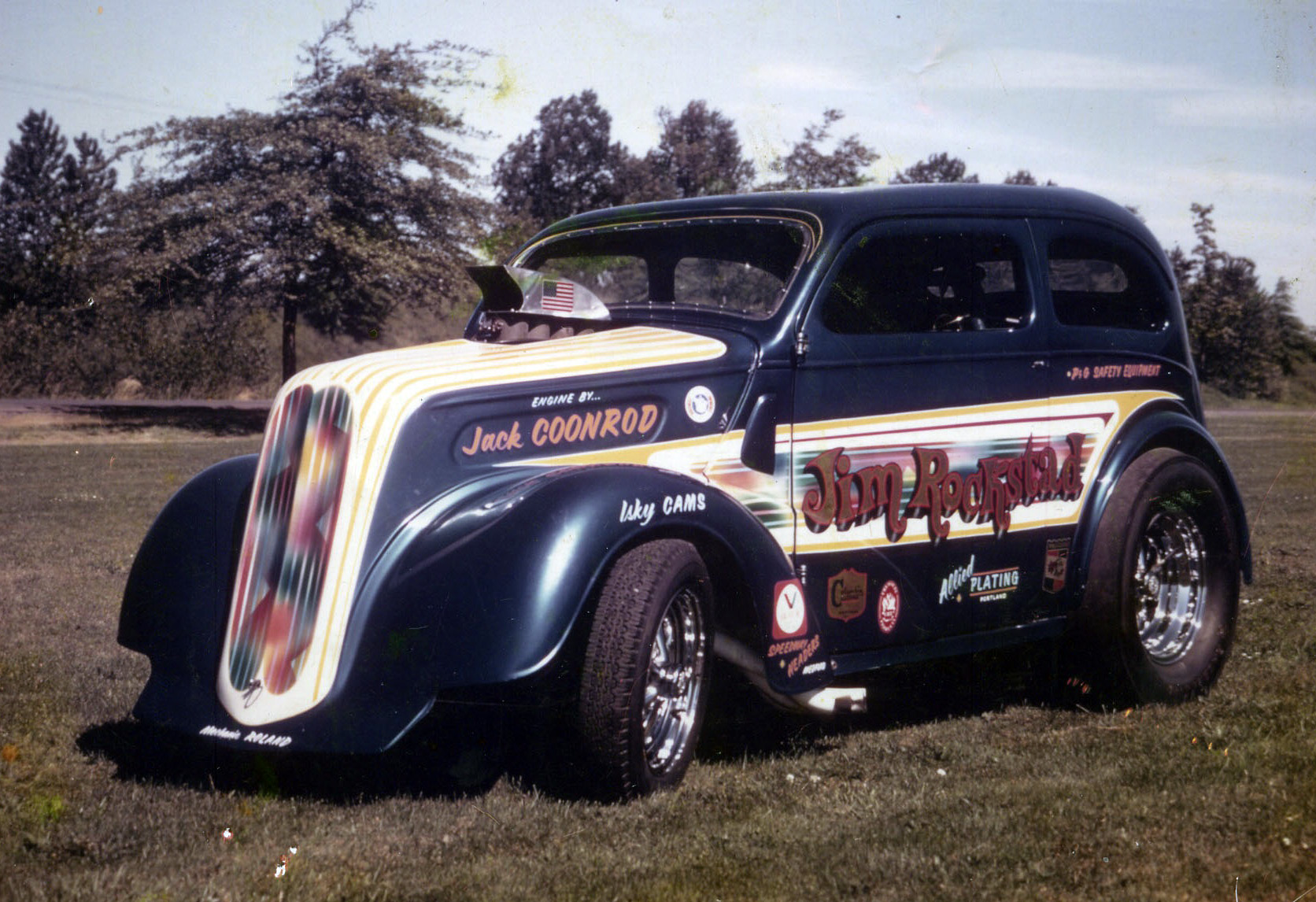
| Team Profiles | Community |
 |
||||||
|---|---|---|---|---|---|---|
 |
||||||
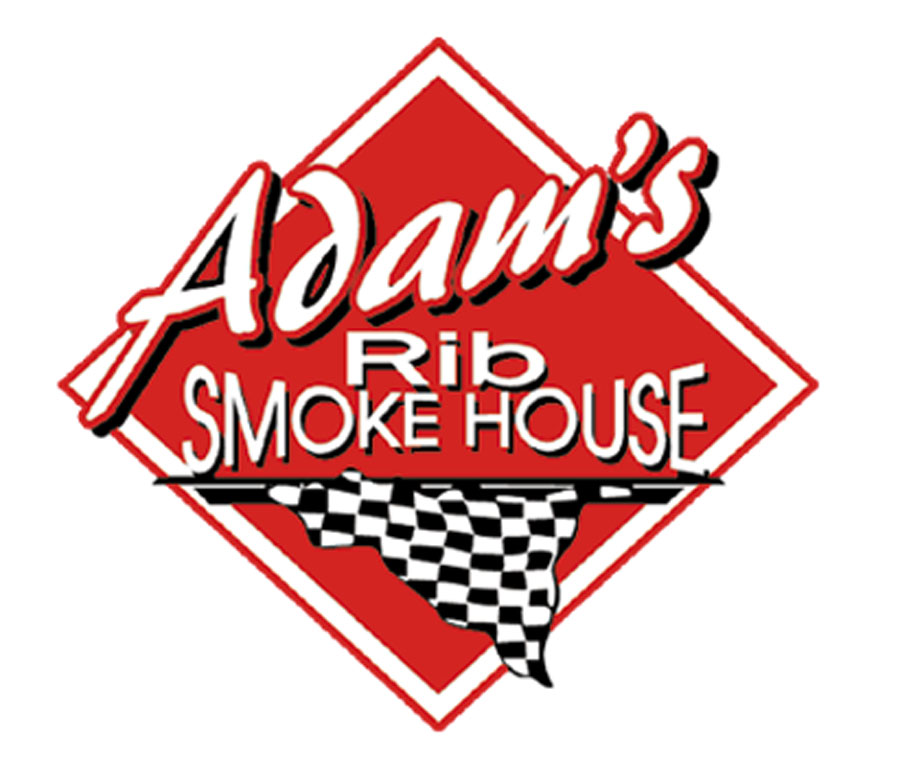 |
||||||
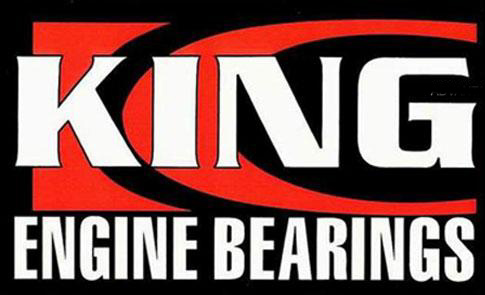 |
||||||
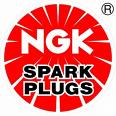 |
||||||
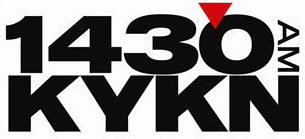 |
||||||
|
THUNDER IN THE PIPES #1:
Rainouts are the Bane of Drag Racing
By Jim Rockstad
A bane: “A person or thing that ruins or spoils.” Well said, Mr. Webster.
“Having major drag racing events in the Northwest can be down-right foolish.” I have heard many a statement like that when I was standing somewhere at a race track – attempting to stay dry – as the rain pounds down and thus eliminating a day at the races for everyone.
The race fans, racers and the producers of such events go through a lot of frustration when the “sky starts falling” in buckets. The negative attitudes start showing because all of us involved would like nothing more than to complete the events.
In all my years in the sport, I have heard many statements sounding like the promoters or producers of these events have caused it to rain. Incredible!! If there is anyone with the hugest risk in the picture, it has to be the promoters . . . and I do mean huge.
Scheduling for both Portland and Seattle needed to be accomplished by November for the next season. With all the groups and clubs that use either facility, everything has to fit so there isn’t a lot of competing with similar events on the same weekend at both tracks. We would have to pick and choose race dates, staying similar year-to-year, because the domino affect is in play here for sure. Move one day or weekend and everything goes haywire, so staying close to the same dates each year is the best thing.
Boy, it would be awesome if you could possibly pick the rainy weekends for the next year! You simply set them in place and finalize the schedule. Contracts with groups and clubs are finished by the first of the year and away you go. Some years are a whole bunch worse than other years, weather-wise. It is what it is and you just work through it.
A rainy day keeps the Kaiser and Rice entry in the soggy pits and the fans away from the track
Once the racing schedule is complete, I could pick out about three days of the entire year knowing that if a downpour happened on those dates it would put me completely out of business…..I don’t mean a huge loss, I’m saying completely out of business. Now that really does make a person uncomfortable! That is a perfect example of how delicate this whole business of scheduling drag racing events in the Northwest really is.
I used to weigh the idea of fewer events or keep it the same, knowing that the more events you have, the bigger the chance for rainouts. If you had fewer events, it lessened the potential for rain showing up on race day. What that did, of course, is take away any opportunities of scheduling more events to make up for the rainouts. That is always hard to figure out: Less is more. It sounds like a Miller Lite commercial.
And then there is the fact that the weather changes each year. Sometimes we get lots of sunshine like 2009 or the mess we had in 2010 and 2011 where it was cold and rainy almost to July. I would hate to be dealing what took place in 2010. The bad economy along with tough weather is a double-barreled mess. Thanks, I’ll stay on the sidelines.
I remember one year seven out of ten major races between Seattle and Portland had some sort of rain fall on them. Either they totally went away or the events were moved to another date in an attempt to finish them. That same year, over a period of six weeks, there were four major events scheduled – two in Seattle and two in Portland. The first two back-to-back races were rained out. Both events were rescheduled with a two-week window in between, and the two weeks of reruns were rained out.
And, by the way, the two weeks in the middle were sunny and warm….in both, Seattle and Portland!! That, my friends, makes a promoter stare into the mirror for a long, long while.
Also, I remember a “lovely” storm came blowing in, with an approaching front, over one weekend way back in the 1970s. We had scheduled an early eight-car funny car show on Saturday night in Portland and then the same pro cars ran on Sunday in Seattle. That wonderful storm got them both of them – a total washout!! A solid weekend of the “wet stuff”, in both markets took place. Ouch!
The financial loses for this one weekend is a gut wrenching experience, to say the least. It’s not easy coming to the office Monday morning and facing up to the headaches that exist from that happening……even if you did everything right!
In the ’70s and early ’80s, the media purchase for just one of those early season events, through mostly radio, was in the $10-15,000 range for each one. Of course, if the race cars are from out of the area, they have to stay in business and their only recourse is ‘rain dollars’ (how is that again?) from the promoter.
So the lonesome promoter has dug a huge hole in his company before the season has even started. You are in such a deep mess you have to look up to see the bottom of this financial disaster. How in the world can you make up for this giant deficit? You have huge problems and the rest of the racing season is straight ahead.
Thunder in the Pipes: Part #2: Rain is a pain
“I made it through the rain, I kept my world protected”…
By Jim Rockstad
That song by Barry Manilow certainly doesn’t apply in the world of promoting drag races in this part of the country. Keeping your world protected isn’t applicable while promoting drag races around these parts. Without a doubt, it has to be one of the toughest businesses anyone could possibly be in.All your efforts (and a lot of money) just go right down the drain, literally.
Remember also that these Northwest race track companies go nearly all winter without any income. To get “nailed” with rain several times this early in the racing season is exceptionally hard to take. I’m not sure that I could have made it through all of those years without something like that protection plan.
There is not a bank in the world that would loan anyone to finance a drag race in the Northwest. The risk is so high and it is a major stress-point to go through that.
I’m glad that I am looking back and not the one attempting to produce these events here in the Northwest.
On the spectator side of the picture, they would get rain-out tickets for face value at other events at the facility, generally good for one year. Although there was a lot of grumbling going on started falling, they did have their purchase value saved by retaining their ticket stubs and calling the racetrack office. Of course, they could have traveled a long way to get to the race track . . . but what can we do?
I knew that I had to come up with a solution for all of this. I went to the radio stations and said, “I need help, a no-cost radio schedule so I can rerun this event”. They thought I was crazy. Some of them said, “No way”. Others went along with the plan and gave us some complimentary radio ads so I could rerun the event at a different time. Understand that the ones that stepped up to help us got bigger schedules of ad buys for the other 4 or 5 major events during the racing season. With some of them I would include some signage at the raceway to pull the whole thing together. Over the years it became the norm with several of the stations.
As I told many of them this racing business is unique and requires different solutions than someone selling jeans or hamburgers. We were a big media buyer in the marketplace and it was important for us to be on their airwaves. They would have to bend somewhat to help us when these kind of things happen---or we would be out of business.
Rain outs are negative all the way around. We, the promoters, have no way of stopping or even starting the rain. So if anyone had such a massive risk/loss problem, it was us. I certainly wished that it would never rain on one of our events but we all know that it rains a lot here and that is why it is so beautiful and green.
There have been a lot of unreasonable verbal reactions that have been taken over the rain issue . . . which is really uncalled for. Those actions don’t assist us at all. We were getting a financial bath and the negative attitudes just made things worse.
There has been many a time that I would just dig into my pocket and hand some grouchy
ticket holder some money….just simply to move on. By just handing out some cash things seem to come to an end. Life is too short to just listen to a whole bunch of loud yelling folks……I certainly hate the mess we were in a lot worse than they do.On the race team side of things, we were the source that assisted them in their cash flow because they would have no income for the weekend. Yes, it is true that we are “swimming in a pool of red ink” and the race car guys understood that. Well, most of them did.
If they were local cars, so be it. They could spend a few hundred dollars driving from Seattle to Portland and back. Most, if not all, accepted that scenario. If you become too hard to deal with, just maybe it wasn’t worth it on either side. Where would that get everybody? They needed the races and we needed the cars. It’s pretty simple.
Thunder In the Pipes Part #3
“Rain drops keep falling on my head”--B.J.ThomasBy Jim Rockstad
Often times you see a blue area or hole in the clouds during a rained-on event and you say, “Okay, dry the track we are getting ready”. After a group of helpers run trucks and cars over the wet areas along with some using a few brooms and propane torches…it rains again. Jerry Ruth, with all his wisdom called those areas in the clouds, “sucker holes”. It seemed like, over all the years of rain-outs, all those blue holes in the clouds ever did was tease everybody. King……good insight!!
The relationship between those producing the events and the professional racers has to have a little “deal” flexibility or the rain could do in both of them. Getting too many rain drops on your head could eliminate both sides in a hurry. Both sides are in the same boat (so to speak) and working it out the best they can is the only thing that makes sense.
In the mid 70’s when Bill Doner (pictured) had seven race tracks up and down the West Coast, you wouldn’t want to get too heavy about the rainout dough. With the exception of a few really big stars in the sport, Doner could pick and choose which cars he wanted, or didn’t. I remember hearing about the worst of the worst: A major financial mess took place at SIR (Seattle International Raceway) at a rained-on 64 funny cars. Always a giant gamble in the Northwest, this event was held in the middle of summer to insure (as best possible) that the event was always held in dry weather because the risk was so incredibly huge.
The teams were from all across the country and a one-day event was extremely dangerous – a potential rainout was only one good shower at the right time. Even if it did get dry later in the day there was that dreaded SIR curfew to deal with. Run past the curfew and the fines from King County began. Not a good thing.
It was Saturday, August 7, 1976. As hard as it is to believe, it rained all day long and into the evening. The only option that day was to reschedule the event on Sunday – against the Unlimited Hydroplane races on Lake Washington.
When Sunday rolled around, it was a cloudy and cool day, but dry. Those conditions simply meant you had to run the cars no matter how many people came to see them.
Those conditions were like the “perfect storm” (if you will). Everything was against any possibility of doing well financially on an event like that. The cloudy and cool day made it unattractive for many spectators; the hydro races were going at the same time andthe racing surface was slippery as can be due to the rain-soaking it got nearly the entire day before.
Both the Seattle Times and Seattle P.I. estimated the crowd size that day at about 7,000. Assuming their “guess” was even close, that was less than one third of the crowd size in 1974 when the same event produced a record 25,840 spectators. That figure was “the largest one-day crowd anywhere in the sport, other than a National event”, according to Doner at the time.
As a side note: On the performance side, it was the second win in a row for Raymond Beadle and the Blue Max from Dallas, Texas. Popular local driver Mike Miller, from Mountlake Terrace, had worked his way into the final against Beadle. In an example of the conditions that day, Miller was disqualified as he crossed the outside line of the drag strip in that final, simply handing over the easy win to Beadle.
The cloudy and cool day was not only a financial disaster for SIR, but Miller had the chance of his lifetime slip right through his hands. Beadle slipped and slid down the race course for the win.
It was earlier that year when Doner purchased a major section of grandstands from Sick’s Stadium in Seattle as he attempted to keep up with the continuing growth of 64 funny cars. The old ball field for the Pilots was being torn down and they were selling everything, including all of the seats. Those grandstands were to be completed in time for 64 funny cars that year, and they were. That event was out-growing the existing seating.
It must have been an extremely tough sight to see the estimated crowd of 7,000 sitting in the new seating arrangement that day at SIR. The newly-expanded bleachers could easily handle over 20,000, but it was not to be.
In 1976, with the rain all day and evening, the event was rescheduled to Sunday--against the hydros for Seafair. The freshly installed grandstands were there but the crowd stayed away from the cool and cloudy day.
The new grandstand was nothing like today’s modern aluminum seating. That new grandstand was all wood. A complete concrete foundation had to be poured first and then the entire grandstand was to be reconstructed at SIR, piece by piece. According to the NHRA, these stadium-type grandstands at SIR were the very first ever to be installed at a drag strip. It was a huge section of grandstands which took lots of labor all summer to get them finished and completely installed.
Like any business, SIR already had the extra costs of buying and installing the grandstands, but it was devastating when 64 funny cars rained out in 1976. That was responsible for a giant financial problem.
In the Northwest motor sports business, this whole stressful picture was multiplied by the fact that the income runs out at the end of September (and the bills continue on all winter).
THUNDER IN THE PIPES:
Back in those early years they were called “sleepers”By Jim Rockstad
In the late 50’s and 60’s there was a “class” of street racers called “sleepers”. A basic plain looking, and sometimes odd make or model, vehicle that looked like an off-the-shelf stock car. The outside of the car was kept basically stock, hubcaps and all along with stock paint, stock mufflers-nothing on the outside that would give away what lies in wait under the hood.
These “sleepers” would hunt out the tricked out rods or other racy units and look for a
“get-it-on street race”. In most cases, these sleepers would devour a flashy looking hot rod.
A good friend of mine, Chet Thomas, back in these years had a sleeper of all time. He had a 1948 Pontiac Silver Streak 2-door sedan……black, of course. The trusty old straight 8 was junked and replaced with a huge 389 cubic inch Pontiac V-8 with triple 2-barrel carbs. He hooked that huge motor up to a Cadillac LaSalle floor shift transmission. As I read up on this old Pontiac V-8 it was listed at 345 horse power which was very capable of scooting this heavy old Pontiac 2-door along just fine.
The car was totally stock looking. One tail pipe out the back (the other one was hidden away underneath the car). Stock tires about 4-5 inches wide and with hubcaps, of course. You would never know that this thing was a bad hombre—a true sleeper. It would, literally, ignite those hard-rubber narrow little tires at will, for as long as you wanted to.
In typical era-style you had to fabricate just about everything to modify old cars. Often times that meant using a long piece of wire hooked to the carburetors for a throttle. A quick yank was all that was needed to open all three carbs for Chet, when needed, but it was really tough shifting that LaSalle transmission at the same time…lots of craziness back then, for sure.
The car was a “barge” on wheels but, boy, did it ever get the job done. Many a hot rodder in their slick machines had their jaws drop open when Chet would thunder on by. It had to be quite embarrassing if you were sitting in your ‘ole ’23 Ford “tub” roadster your girlfriend by your side and this monstrous Pontiac would come “boiling” by. Just like the song says. “Another one bites the dust.”
My brother found a ’49 metallic blue Ford 2-door sedan. He ended up wheeling and dealing for the car as the transplanted ‘56 Desoto hemi power plant was all frozen up. The motor was then pulled and rebuilt so that this beautiful stock-looking Ford became an all-time ‘mean’ sleeper in North Portland. The car, very impressive back then, ran 89 miles per hour and in the 16 second bracket on the drag strip. That was in 1960 over 50 years ago.
The only way you could tell anything about this sleeper was you could vaguely see traction bars hidden away underneath to assist getting the power to the earth—that was it. Floor shifter, quiet mufflers with 291 cubic inches and 255 horsepower…..this thing really got with it….or should I say, ‘really hauled the mail.’
The late Ernie Hall, of Cornelius, Oregon, showed all of us that Desoto (Mopar) made a dynamite hemi motor. His long list of fast dragsters used these same Desoto motors with great success. Chrysler Corporation quit making the Desoto vehicle in 1961 due to lack of sales…..too bad as this smaller and lighter hemi motor was perfect for hot rods.
Dick used to cruise around to many of the active street racer spots throughout the Portland area. The Banfield Freeway; the Firestone Warehouse had a great strip along side; T-4 certainly was one of the best places; Delta Park, on the old vacant streets there and a small little Gertz Road out near the airport were all hot and heavy for the street racing scene.
That bad-to-the-bone blue Ford was the terror of North Portland. Dick had a “victory” list of cars that were beaten by his blue “rocketship”. 26 cars on that list, most of them were Chevies that had fallen prey to Dick and his car. Gertz Road was the great place to race locally and this Desoto powered ’49 Ford would take on all contenders.
Back in those days on these street races it was all about ‘flag’ starts…..exactly like the movie American Graffiti presented it. A finish line would be marked and the two competitors would roll out together, line up side-by-side and the flag was dropped as the two combatants got after it.
Crude, crazy and especially unsafe but it was reality back then. Certainly not sensible but a lot of things back then were not sensible.
Finally, two Chevies gave the little Ford (that could…and did!) a “dead heat”….no wins, but a couple of dead heats. It was an unbelievable record for an unbelievable car.
Admittedly, I raced that car myself a few times over at Benson High School in Portland.
Dick had me work on the car a few times as the stock Ford axles were pretty whimpy for the hemi so I would replace them and then get to use the car. I went there to an automotive class in the afternoons and many guys there thought that they could eliminate this pretty Ford—they were thinking flathead powered. (chuckle) Needless to say, that Desoto motor blew them away quite easily time and time again.It was all in a days work for the blue Ford—a sleeper that woke them all up back then.
THUNDER IN THE PIPES Part #7, History
“Sneaky” Pete Robinson Comes to Woodburn
By Jim Rocks tad
Okay Northwest race fans, here it is:
The Northwind, the number six car in the nation back in 1965, challenged the number one fuel dragster of Georgia’s Pete Robinson. Back then the Drag News format was pretty simple to become the #1 fuel dragster in the nation: A best 2 out of 3 match race at a chosen race track would settle the challenge with the overall winner either retaining the highly desired number one spot or gaining the top spot.
You had to be on the list to challenge for any spots above where you were. To even make it on the list you had to perform well as Drag News monitored the better cars throughout the country each week.
The site had been chosen along with an agreed upon date: Woodburn Drag Strip, Saturday, June 13th, 1965.
Then a money deal between Al Beachell, Woodburn track operator, and the Drag News #1 fuel dragster along with the Northwind group had to be reached so that the combatants could be properly compensated for their efforts.
Once that ‘arrangement’ was made with “Sneaky” Pete Robinson, who was the current #1 spot holder in the Drag News Top Ten, the Northwind boys began preparing that gold car for the race of its’ young life. If the number six car could beat the number one car it would have to be the biggest thing that ever happened here in the Northwest at the time……nothing in drag racing even came close.
Back in those days being #1 in Drag News was better than anything that could be accomplished in the sport. If the Northwind could win this match race on it’s “home soil” it would be unheard of in drag racing circles. A group of guys from the tall woods of the Northwest won the Number One spot in the nation. What a huge accomplishment.
Robinson was attending an NHRA National event the weekend before the June 13th match race at Woodburn, so he had a long way to tow in a short amount of time.
An offer was made to allow Robinson to keep his racer at Columbia Racing Engines in Portland so he could pull the necessary maintenance—but, interesting enough, he never showed up there. Once he arrived in Oregon he went straight to the race track. Robinson never phoned so everyone on Team Northwind wondered, “Where is Pete Robinson?”
Just maybe he was being a little sneaky.
There was the old familiar off-and-on again showers going on that day as the Northwind crew headed to Woodburn Drag Strip, 30 minutes south of Portland. The huge crowd was waiting to get in the facility as they were anxious to see if the Northwind could stand up against Robinson.
Once arriving at Woodburn Drag Strip there was the trailer and tow rig of Robinson’s that was still parked in line as he had been sleeping there at the front gate. He had towed all the way from Bristol, Tennessee to defend his title in Oregon. No doubt, he was plenty tired.
Psst: Hey, that could be a wonderful sign.
Thunder in the pipes: Part #8 History
The Day Arrives For Historic Woodburn ShowdownBy Jim Rockstad
Its’ showdown time at Woodburn Drag Strip with the Northwind fuel dragster, as the #6 car in the Drag News Top Ten List takes on Pete Robinson for the #1 spot, which he holds.
As the la
rge crowd began to hustle into the race track the early morning showers were starting to cease. It certainly looked like it would be a great and historic day of racing.
Hopefully, the end result would be great, also.All of us on Team Northwind were hoping that Sunday, June 13th, 1965 would be a day
that the entire drag racing world would remember. The opportunity was here and the weather was shaping up perfectly.No one on the Northwind crew knew which motor Sneaky Pete Robinson would have in his “Tinker Toy II” dragster, the 427 cubic inch SOHC Ford or his trusty small block Chevrolet. He, often times, would switch motors depending on need, track surface being the most vital consideration. Apparently, the Ford motor made lots of horsepower but was the heavier of the two. The small block Chevy was often the choice he did make.
A little knowledge about the power plant in the Georgia racer’s car going into the event certainly would have been great to have for Team Northwind, just for strategy reasons, but that just wasn’t to be this time around.
Any advantage at all might just be huge for this match race.
I always felt that Jim Albrich was the slyest of them all. He had been building really fast Chrysler hemis since the late 50’s, even welding and grinding his own stroker cranks to increase the cubic inches and improve the horsepower. Without a doubt, he was one of the best motor guys in the country.
A number one on the tail of the Northwind would be exactly where it should be, in my view. The impact of this match race and subsequent results would be huge for the sport of drag racing in the Northwest…..that is, if the Northwind could pull it off.
Albrich knew that he had to just run as well as the car had done the month before at Woodburn beating good friend Sid Waterman. This Chrysler power plant had run some big numbers earlier and we all knew that Jim Albrich would not back down on this important day. For Team Northwind this was the biggest and most important event ever.
Just remember this Kent Fuller built race car is just barely 6 months old. The unique chassis setup included an internal set of ladder-type bars that coupled the motor and the rear end together and used small coil springs, similar to valve springs, instead of a conventional solid mounted rear end. This design allowed the torque of the motor to “force” the rear wheels into the ground for greater traction. The front axle really had no suspension at all with a rubber “biscuit” in the center of the axle mounting which connected it to the frame. You could lift either front wheel straight up 3 or 4 feet without lifting the opposite wheel as the rubber biscuit allowed a great deal of pivot.
It was both genius and radical in design at the same time.
Earlier in the season the ill-handling Northwind was giving everyone involved fits. It was off-and-on handling where the car would make excellent runs and then almost out-of-control runs. After several test runs at Riverside Raceway with Jeep Hampshire as the driver, it came down to it must be the magicar setup causing all of these problems. Jeep drove the car to make sure that Ed McCulloch wasn’t the problem—for sure it was the exotic setup in the chassis.
Once the magicar chassis was converted back to a conventional setup it was very consistent leading into this challenge for the Number One spot. That consistency would be of utmost importance on this day. Contact Us
Well, I’m here to tell you, waiting a little time for round two was even worse. Your mind plays all kinds of major tricks and ugly scenarios to what could possibly go wrong. You have to fight away the blahs and just focus on the job at hand.
Check everything on the race car time and time again. Of course, being a “grunt” as a 22-year old on this team, the last thing I needed to do was make a dumb error or overlook something that would mess up this day. That would be a big-time bummer in this whole picture…….certainly, something I didn’t need.
We have won the first round at 7:62 and 199.52 miles per hour. I believe Albrich will step on it a little harder to improve the chances of winning this round. Robinson, on the other hand, ran only 7:95 in his losing effort.
You just have to believe that Robinson will come back in round two and run really quick.
He had never run at Woodburn before (I believe that) and so now he has the needed information and feel for the track…..we better look out in round two.Round two was finally ready after several sportsman cars had run in both lanes insuring
a clean race track surface……not a lot of track cleaning equipment back in these days. Both teams had made their respective adjustments or changes and it was time to get things underway.With both cars already staged it was hard to really know what would really take place. I was just excited as can be that the Northwind had fired up again and I didn’t make any mistakes to foil this whole thing as we were heading towards the starting line….whew!
Knowing that round two was a must-win Robinson left early and essentially red-lit away his number one spot, leaving the starting line very early. McCulloch, on the other hand, blitzed down the Woodburn quarter mile at an unrelenting 7:50 and 206.42 miles per hour—no doubt, with a huge grin on his face the whole way. There was no easing or slacking for the Northwind, there was only determination and, of course, plenty of horsepower……from that CRE motor.
Interesting enough, Albrich ran a Crower DG206 roller camshaft…and yes, the 206 stands for miles per hour. The DG part was Don Garlits, as he had input in the design of this particular camshaft.
That Jim Albrich-tuned Chrysler had stepped up even further for round two running extremely quick and fast. How exciting is all of this?
The Northwest gathers up the Number One spot on the Drag News Top Ten Fuel Dragster list right here on home soil—Woodburn Drag Strip. Just maybe the biggest motor sports action to ever take place in Oregon.
In unison the massive crowd went into a frenzy of excitement seeing the local guys win this match race and that Number One position….and they did it in just two runs.
Our great friend, and an accomplished supercharged gasser racer himself, Steve McGee, said it best as he was there in that huge crowd, “That is a day I will never forget”.
Or will I Steve.
Ahead for TITP is a multi-part series on rain on drag races, a behind-the-scenes account of the frustrations brought on by the moisture we have here in the Northwest. But first astory on what the costs were like in the late 50’s……coming next.
See more to this great story below! editor
THUNDER IN THE PIPES: Part #9, History
More Sneaky Pete vs. the Ace at Woodburn
By Jim Rockstad
The gates were wide open at Woodburn Drag Strip on that Sunday morning in 1965 and the lines were long as they were anticipating a big-time match race for the Drag News #1
spot in the nation.With the rain completely stopped, a group of local sportsman racers were beginning to make passes in an effort to completely dry off the Woodburn racing surface. In these early days, a clean surface was all that was needed for fuel dragsters no gluing of the asphalt took place.
The combatants were secretly working through their strategies and plans for the day in their respective pit areas.
Jim Albrich remembers that Pete Robinson was all set to do a warm up just prior to the
first round of the showdown which was set for 1:00. Twice Robinson pushed the car down the drag strip and both times the dragster refused to start. What’s going on here?
They do call him “Sneaky”….could this be a plan to outfox the Northwind guys or was he really having motor problems…hard to say.Maybe he didn’t get enough rest after that long tow across the country. Whatever the case, there was some head scratching going on by Albrich and crew.
It seems as though Robinson had removed his rocker arms on the fuel burning small-block Chevy to assist in saving the valve springs and had forgot to put them back on. Why did that take two tries to figure that out? Sneaky….you bet! At least, it looked a little fishy.
Team Northwind had to wait for some time as Robinson got his motor all together, warmed up and ready to go. There was a lot of wondering going on at this point as Pete Robinson had a Degree in Engineering from Georgia Tech. Could he have been trying to confuse everyone right before the first round…..who knows?
Finally at 1:30 round one was ready as the two teams sat anxiously at the front of the staging lanes….ready for combat. McCulloch was all strapped in as the waiting was finally over. In the other lane was Robinson in the Tinker Toy II fuel dragster all set and ready also.
You can only imagine what McCulloch must be thinking as he peered through his goggles, looking down that quarter mile, while awaiting his turn. It was the year prior at that same Woodburn Drag Strip where McCulloch crashed his Chevy-powered dragster saying “I don’t ever want to drive again.”
Not only is he driving and doing an incredible job at it, he is now competing for the number one spot in the nation. That is remarkable for a guy that never wanted to drive again.
You could hear the crowd as they cheered while the two teams pushed their race cars down the drag strip for the fire-up. Push starts were commonplace in the 60’s well before starter motors were ever used.
In the later years, starter motors would replace these push starts because a lot of not-so-good things took place with this approach. Cut it out—I’m back thinking about what could go wrong.
-------
Once there it was turn around, make any last minute adjustments and then push as hard as the Ford station wagon could. I was really nervous as I had seen several fuel dragsters not fire during these old push starts and with the coolness of the earlier rain….who knows?Here they come as the push rigs were getting up to speed. “Come on big Chrysler you can
fire up right away--pleezzz”…..and it did just that. Both motors came alive and you could hear that deep throaty noise from the Northwind Chizler as the cars arrived for the turn-around at the starting line.You could tell from a distance that Albrich had this Northwind set-up to run hard. It was one fierce-sounding motor as it made the turn-around at the starting line.
The two combatants began rolling forward to the staging with their motors thundering away…….we’ll soon know if these Northwind guys can do it.
THUNDER IN THE PIPES Part #11
One giant win in the books, and hopefully, one more to go.By Jim Rockstad
With a round one win already for the Northwind all anyone could think about was some how winning this match race with Robinson in two straight.
Originally, I thought the first round was gut-wrenching, especially waiting that extra half an hour for Robinson to get his car warmed up and ready.
Well, I’m here to tell you, waiting a little time for round two was even worse. Your mind plays all kinds of major tricks and ugly scenarios to what could possibly go wrong. You have to fight away the blahs and just focus on the job at hand.
Check everything on the race car time and time again. Of course, being a “grunt” as a 22-year old on this team, the last thing I needed to do was make a dumb error or overlook something that would mess up this day. That would be a big-time bummer in this whole picture…….certainly, something I didn’t need.
We have won the first round at 7:62 and 199.52 miles per hour. I believe Albrich will step on it a little harder to improve the chances of winning this round. Robinson, on the other hand, ran only 7:95 in his losing effort.
You just have to believe that Robinson will come back in round two and run really quick.
He had never run at Woodburn before (I believe that) and so now he has the needed information and feel for the track…..we better look out in round two.Round two was finally ready after several sportsman cars had run in both lanes insuring
a clean race track surface……not a lot of track cleaning equipment back in these days. Both teams had made their respective adjustments or changes and it was time to get things underway.With both cars already staged it was hard to really know what would really take place. I was just excited as can be that the Northwind had fired up again and I didn’t make any mistakes to foil this whole thing as we were heading towards the starting line….whew!
Knowing that round two was a must-win Robinson left early and essentially red-lit away his number one spot, leaving the starting line very early. McCulloch, on the other hand, blitzed down the Woodburn quarter mile at an unrelenting 7:50 and 206.42 miles per hour—no doubt, with a huge grin on his face the whole way. There was no easing or slacking for the Northwind, there was only determination and, of course, plenty of horsepower……from that CRE motor.
Interesting enough, Albrich ran a Crower DG206 roller camshaft…and yes, the 206 stands for miles per hour. The DG part was Don Garlits, as he had input in the design of this particular camshaft.
That Jim Albrich-tuned Chrysler had stepped up even further for round two running extremely quick and fast. How exciting is all of this?
The Northwest gathers up the Number One spot on the Drag News Top Ten Fuel Dragster list right here on home soil—Woodburn Drag Strip. Just maybe the biggest motor sports action to ever take place in Oregon.
In unison the massive crowd went into a frenzy of excitement seeing the local guys win this match race and that Number One position….and they did it in just two runs.
Our great friend, and an accomplished supercharged gasser racer himself, Steve McGee, said it best as he was there in that huge crowd, “That is a day I will never forget”.
Or will I Steve.
Ahead for TITP is a multi-part series on rain on drag races, a behind-the-scenes account of the frustrations brought on by the moisture we have here in the Northwest. But first astory on what the costs were like in the late 50’s……coming next.
See more to this great story below! editor
THUNDER IN THE PIPES: Part #10, History (next)
The Wodburn Showdown Begins for Top Fuel Title
By Jim RockstadThe ground around the starting line area at Woodburn Drag Strip was shaking as the two combatants had their motors running and the fuel dragsters were slowly rolling forward to stage. It was a nervous moment for both of the drivers as Ed McCulloch was in the number 6 position on the Drag News Top Ten list while Pete Robinson was attempting to hold off McCulloch to retain his number 1 spot on the list.
Challenges for the different positions on the list were commonplace throughout the country but the Northwind just had to be a scary pairing for Robinson as this gold car had been running so well. It’s the best 2 out of 3 as the winner either keeps the number one position or wins the coveted “top of the hill.” It’s a frantic moment for both drivers as it’s all laid on the line especially in this very first round.
Folks, you need nerves of steel in this business. No child’s-play here.
The crowd pushed forward in a valiant effort to see everything that would take place and realizing the utmost significance of this historic battle. They were lined up at the fences on both sides of the Woodburn quarter mile.
This was a tense moment in this sport for everyone involved. You could certainly feel the tension in the air as both race cars continued slowly rolling forward into the staging line for the start.
Here we go--round one. It is time to take a deep breath.
Both cars accelerated away from the starting line as the mighty gold car, in a show of huge horsepower, boiled the tires from one end to the other to the cheer of the large throng of supporters. McCulloch ran a 7:62 and 199.52 miles per hour with Robinson, who gave chase, was trailing in his much slower Chevy car at 7:95. The Jim Albrich Chrysler had just flat overpowered Robinson. Take that—Sneaky!
With the Fuller conventional chassis setup, that replaced the magicar apparatus, the gold car handled superbly which eliminated any of those earlier fears. The Northwind ran straight as a string over the entire quarter mile. That straight, fast and quick run brought a sigh of relief to Team Northwind.
The inside of the station wagon push rig for the Northwind was in a “mass excitement mode” as round number one was a win and in the books. “Let’s get him back to the pits and get ready for round two”, Albrich said, as we pushed the round-winning Northwind back to the pits in front of the cheering crowd.
The wrenches were flying as the in-between rounds maintenance was so easy to do after this first round win. It was kinda like “whistle while you work” for the Northwind group, a round one win. Excitement was definitely in the air.
We knew, at that point, that we needed to repeat and win this next round and not have to stare at a third run. A third run would give Robinson an excellent opportunity and he could certainly rise to the occasion allowing him to retain that big-time number one spot.
Remember, Pete Robinson didn’t get to be the Number One car in the nation by being a slug. The hope is that he bit off more than he could chew against this Northwind group.
Round one clearly showed the capabilities of the Northwind.
As a general rule, Albrich seemed to always run better on the second run at all of the race tracks the Northwind visited during the year, a great and exceptional sign for an excellent tuner. He wanted to run better that 7:62 of the first round as he planned his strategy for round number two.
A little tweak here and a little tweak there….and just maybe, a bigger percentage of nitro would be in the plan for round two. Hey, we are talking thunder in the pipes here!
The Albrich motors were built and maintained at Columbia Racing Engines in Portland. CRE was a pure drag racing motor shop located in a NE Portland location on Union Avenue with a huge list of customers. The threesome of Jim Albrich, Earl Floyd and Wayne Harry, all drag racers, were spreading the gospel of the sport and building powerful motors. If you were into drag racing in the Portland/Vancouver area you probably had a CRE motor, parts or machine work. The motto of CRE was pretty simple: Horsepower is our Specialty.
After that performance in round one that CRE motto is most certainly an understatement.
Once both cars were ready round two would be fast approaching.
THUNDER IN THE PIPES Part #11
One giant win in the books, and hopefully, one more to go.By Jim Rockstad
With a round one win already for the Northwind all anyone could think about was some how winning this match race with Robinson in two straight.
Originally, I thought the first round was gut-wrenching, especially waiting that extra half an hour for Robinson to get his car warmed up and ready.
Well, I’m here to tell you, waiting a little time for round two was even worse. Your mind plays all kinds of major tricks and ugly scenarios to what could possibly go wrong. You have to fight away the blahs and just focus on the job at hand.
Check everything on the race car time and time again. Of course, being a “grunt” as a 22-year old on this team, the last thing I needed to do was make a dumb error or overlook something that would mess up this day. That would be a big-time bummer in this whole picture…….certainly, something I didn’t need.
We have won the first round at 7:62 and 199.52 miles per hour. I believe Albrich will step on it a little harder to improve the chances of winning this round. Robinson, on the other hand, ran only 7:95 in his losing effort.
You just have to believe that Robinson will come back in round two and run really quick.
He had never run at Woodburn before (I believe that) and so now he has the needed information and feel for the track…..we better look out in round two.Round two was finally ready after several sportsman cars had run in both lanes insuring
a clean race track surface……not a lot of track cleaning equipment back in these days. Both teams had made their respective adjustments or changes and it was time to get things underway.With both cars already staged it was hard to really know what would really take place. I was just excited as can be that the Northwind had fired up again and I didn’t make any mistakes to foil this whole thing as we were heading towards the starting line….whew!
Knowing that round two was a must-win Robinson left early and essentially red-lit away his number one spot, leaving the starting line very early. McCulloch, on the other hand, blitzed down the Woodburn quarter mile at an unrelenting 7:50 and 206.42 miles per hour—no doubt, with a huge grin on his face the whole way. There was no easing or slacking for the Northwind, there was only determination and, of course, plenty of horsepower……from that CRE motor.
Interesting enough, Albrich ran a Crower DG206 roller camshaft…and yes, the 206 stands for miles per hour. The DG part was Don Garlits, as he had input in the design of this particular camshaft.
That Jim Albrich-tuned Chrysler had stepped up even further for round two running extremely quick and fast. How exciting is all of this?
The Northwest gathers up the Number One spot on the Drag News Top Ten Fuel Dragster list right here on home soil—Woodburn Drag Strip. Just maybe the biggest motor sports action to ever take place in Oregon.
In unison the massive crowd went into a frenzy of excitement seeing the local guys win this match race and that Number One position….and they did it in just two runs.
Our great friend, and an accomplished supercharged gasser racer himself, Steve McGee, said it best as he was there in that huge crowd, “That is a day I will never forget”.
Or will I Steve.
Ahead for TITP is a multi-part series on rain on drag races, a behind-the-scenes account of the frustrations brought on by the moisture we have here in the Northwest. But first astory on what the costs were like in the late 50’s……coming next.
See more to this great story below! editor
Thunder in the Pipes: History
Finally, and I do mean finally, high school was behind me. You could say that the time in high school was interrupting my involvement with hot rods and drag racing. You would be quite accurate with the assumption. I had the car bug and I was going to follow it wherever it went.
I became a member of the Headers of Portland car club. We had a rented, large garage on the corner of Columbia Boulevard and Union Avenue (Now MLK, jr.) in North Portland.
The garage could hold about 6 cars and we would have our meetings there. This car club was big into drag racing, more than just plain hot rods……perfect for me.The two guys I hung around with the most were Bill “Mouse” Jwayad and Fireman Mike Goodell. Mouse lived close to Jefferson High School so while I was supposed to be in class I was hanging with Mouse.
The two of us decided to build a D/Altered and go drag racing. I’m not exactly sure what
I was going to do as Mouse was really the mechanic, along with doing all the welding on
our machine. I use the word “machine” loosely as it was a 1938 Willys sedan with a Buick straight eight for power. Without a doubt, it was the ugliest race car anywhere. No fenders and this lengthy and/or huge motor taking up the whole frontal area. We used the standard Buick stick-shift transmission, but with only 2 gears. Mouse had welded a chunk of chrome steel directly on the shift lever so the driver would just “yank it” to the next gear. Not exactly an impressive setup.This thing was a legal NHRA D/A car (which, as I look back, is hard to believe). It was a tank, to say the least.
I recall going to Madras several times……….this was like ’62 or ’63. Really, I can only remember pieces of these old days….they were a long time ago. I can recall going over Mount Hood as Madras would open early and us guys that needed to race would head over there. Getting there was something else….snow, snow and more snow. Somehow we made it there several times.
Mouse and I would swap driving this old beast. I recall going up against a Ford flathead
roadster with me driving. I left the starting line and as I was ready to shift I looked back
at the roadster and waved for him to catch……..a little arrogance there! We went on to win the D/A class and win a trophy.While was at the races I would always dream about other cars I would see. Madras had an NHRA points meet and that meant cars from other areas would enter the event. Some of the cars were really trick and out “junk heap” needed to be replaced by something a lot neater.
I would work where I could to get dollars to sink into drag racing cars. I was full-buried into the sport and the more I did in it, the more I loved it……..Keep it coming!!In 1964 I was off to spend 6 months in the US Army Reserve at Fort Ord, California. I was so hooked on the sport of drag racing I would read every copy of Drag News that I could get my hands on, from cover to cover. When I arrived and was checked into the military, I was resting on my bunk reading a copy of Drag News and a fellow trooper asked if I was from Oregon. I said I was and we started talking cars. I told him that a friend of mine, Jack Coonrod, had a ’33 Willys pickup that they were running in AA/GS and he was looking for a coupe body. As amazing as this seems, he said. “I know where there is one”.
Talk about a long shot sitting on a bunk in Fort Ord, California.He told me that it is in a wrecking yard in Burns, Oregon and where I could find it. I wrote my friend Jack a letter
detailing the car location. Jack got so pumped up that he hooked on his trailer and headed to Oregon right away. Small problem though, he headed to Bend, Oregon about 300 mile away from where the car was. Once he realized the problem he headed out to the right place and there it was…..a “33 Willys coupe in a wrecking yard.That very body was later mounted on the gasser chassis and the car was off on several years of touring on the gasser wars back east.
Later in 1964, once I was released from the Army Reserves, I headed back to Portland and the job I had at Lord Brothers Construction. My position was a re-fueler on all of the
big machines at different job sites around the Portland area. I would drive around town and fill whatever rigs were needed and then head over to the shop that Jim Albrich had at his house. Wayne Harry, Jim Albrich and Earl Floyd would be building race motors and I would sit and drool there as long as I could. I could only dream and hope to being involved in a bigger way in the sport of drag racing, some day soon.As a new year rolled around in 1965, I got a huge opportunity to walk away from Lord Brothers and work on the new Northwind top fuel dragster. Boy, was this big-time for me or what. (when I told one of the bosses at Lord Brothers what I was going to do…..he said, “Are you nuts?”) I certainly didn’t see it that way.
Ed McCulloch had got involved with Jim Albrich as a partner and Dennis Kreiger (Ed’s
cousin), had purchased the latest in Kent Fuller race cars. This new car was so long it didn’t event fit in the garage as a set of stairs had to be removed to make it work.My job was to be the driver of the tow rig, a ’65 Ford station wagon, and I would do all the grunt work needed. Really, it was much of a job but an opportunity like this for a guy that loved the sport of drag racing was huge. No more fueling construction machines, I’d be fueling this top fuel dragster at drag strips all over the west coast. Of course, my folks thought I was semi nuts but as you’ll see as you read on, it all works out in the end……whew!!!
Part 1: The Genesis of PIR and 32 Funny Cars
By Jim Rockstad
Bill Doner has always been famous for his outlandish, one-of-a-kind promotions. As President of International Raceway Parks, Inc. in the 70’s, his corporation produced events at seven different race tracks throughout the west. He personally voiced and produced all those creative radio ads from Seattle to Los Angeles, Irwindale to Fremont and Portland, along with a couple of other race plants up and down the west coast. Even to this day, his rapid-fire, hard-hitting radio ads are often talked about and remembered as a great piece of Americana. Those ads have had long lasting impact!Up and down the west coast, the multitude of events always took different shapes but they were never short on ground-pounding excitement. There was the Professional Dragster Association series (PDA), huge funny car events, National Opens, Fox Hunts (all girls are free) and a long list of stunt shows included at drag racing events. Always controversial, but certainly never dull…..that was, and is, Bill Doner.
The Doner-style creativity is unparalleled in the sport…..and so was his ability to put together the 7 racetrack trail leading from Seattle, in the Northwest, to Orange County in Southern California. From a pure business perspective the multiple bookings of the most popular cars in the sport was a perfect move throughout the west coast. He could offer race fans different race teams than they had ever seen before at their local drag strip. Big-league drag racing would take place right there in their own back yard. Talk about convenient it was like going to the local movie theater to see some major presentation take place in the great outdoors. These motorsports presentations had those eye-watering nitro fumes and plenty of ground-pounding action…all in one evening where you could be home by 11:00pm.
For the racers it was a perfect scenario also. Doner could book them in several different race tracks and if one got rained out he could make it up to them at another race track. They had some insurance if inclement weather spoiled their scheduled date as they all needed the income to survive. The cash flow was so very important….in those days, when it stopped the race team came to a halt. Having one guy control nearly the entire West coast made for good results on both sides of the picture…..for the racer and also for the race fans, both, for the better.
When it came time for the City of Portland to bring in a new promoter for drag racing they needed to look no farther than Seattle International Raceway, the home of Bill Doner and IRP. It was the perfect match-up for motorsports fans in the Northwest.
With the huge success that Doner had already had in Seattle, if he could just get Portland in line, the facility there would be the perfect “stepping stone” to that Seattle event. Similar to the concert venues, being able to double-date these race cars would allow for a dynamite, summer-time, local happening, in each of these markets. Seattle was already established and adding Portland into the mix would really lock in the future for this unique program. There would be nothing like it anywhere else in the country.
With Portland International Raceway coming into the IRP fold in 1973 immediately a 32 FUNNY CAR event was established there to give the touring cars another race date. More races in the Northwest would assist in covering their costs to travel to the Northwest. Better quality of cars, the bigger the crowds. That was the plan for Portland on Saturday night in late July before Seattle’s 64 funny cars.
This is an aerial photo of the Vanport area (now PIR) where the community of houses for the shipyard workers were once located. The dike on the perimeter Columbia Slough broke flooding the entire area in the 50’s eliminating all the homes there.
In the 60’s the vacant streets were used for street drag racing under the direction of Portland’s then-Major Terry Shrunk. His plan was to allow local “gear heads” a safe place to race instead of the continuing street racing that was taking place through-out the area. The program worked well and laid the groundwork for a future race track to be located within the park-like atmosphere that was developed at that site.PIR would need a lot of improvements to accept the larger crowds…there needed to be a lot of things happen in a hurry. The season had just about arrived, the push is on.
THUNDER IN THE PIPES: PIR makes a big-time impact on the sport of drag racing.
THUNDER IN THE PIPES: Part #3
Lets’ see….1-2-3-4…how many funny cars?
By Jim Rockstad
Bill Doner has always been a huge risk taker, willing to let it all happen, just to do something bigger and better than before. As a former sports writer for a Southern California newspaper, you would think that he could juggle a lot of things all at one time. But remember, he had seven race tracks to deal with at the same time and he was producing radio ads for all of them. Additionally, he would have to keep all the race car deals, locations of cars and a zillion other details whirling around in his mind during the racing season.
No doubt, that could get a little overwhelming at times. More than a little overwhelming!
Maybe with all these funny cars going here and there (and everywhere) it is more than one guy can keep track of. Back in these days, the average funny car team attempts to run as many race dates as they possibly could.
In other words, when having funny cars coming from throughout the US and Canada for the Big Show in Seattle, it’s pretty easy to get confused with where they will all be the weekend before. With hundreds of radio ads essentially counting the number of cars you say you WILL have and offering double your money back IF there is less than that established number….well, you’d better be right, not just close, but right!
In reality, this “double your money back” approach for this event was a sort of a dare to race fans to come out to PIR and find us wrong…..just count them and try to double your bucks. It was sort of a line drawn in the sand…be there and check us out.
Would that be appealing to a huge throng of folks? Read on.
With just a couple of hours before the Portland event does the customary fire-up with all the cars and this massive audience jammed into PIR, we all felt it best to make sure that 32 funny cars really did exist, not a bad idea. After all, some of the race fans had entered the race track nearly 8 hours before the funny car segment of the action so they could have planned to count the cars as they arrived. Just sit at the gate with a counter.
With the pits full of “floppers” it is pretty hard to be able to count each and every one. Huge trucks and trailers along with a bunch of sportsman cars were all spread out throughout the area. We just knew it would be tough for the average race fan to get the numbers exactly right as the pits were all stuffed and those pits at PIR are really not very big.
Of course, we had to wait until all the race car teams had arrived that were planning to be there and to make sure none of them had broke down on the highway somewhere. The counting had to wait until late afternoon to go through the numbers. All the teams had to be there several hours before the exciting fire-up that would take place at 6:00pm.
With I-5 bordering the race track on the east side and PIR located only 15 minutes from downtown Portland, the potential is perfect for a giant of an event if you find the right combination. As always with the Northwest, the weather factor always plays into the picture…..this time around it was perfect.
It would realistically be pretty hard for someone to find all the cars, count each one and make sure that 32 of them really did exist….as the radio ads say. At the time we were thinking, “We do have more than enough funny cars to cover ourselves, uh, right?”
But with hundreds of hard-sell radio ads bombing the area for 2 weeks and the folks out there that have been questioning the size and quality of this show….what if a lot of them found out different? Crumb, be one car short and this place could get a little wild as the evening wore on.
Although it would be hard to count them in the pits but just before the first round we roll them out on the track surface for the fire-up. Its’ two rows and you can count them really easy…..let’s see here, we have two rows with 16 cars each…..easy to count, very easy!
We had hours of discussions about this potential issue as the crowd kept coming….and kept coming. We were all flat nervous….for sure!
Counting to see if there really were 32 funny cars could just be a minor part of the problem if we are wrong.
THUNDER IN THE PIPES: We started hearing a buzz about not enough cars…ugh!
THUNDER IN THE PIPES: Part 4
I started hearing the buzz about “not enough funny cars”By Jim Rockstad
32 Funny cars lined up in Portland in this shot Tom McEwan, Twig Zeigler and Kenney Goodell can be seenThe race fans at PIR had been buying tickets for about 8 hours since the gates opened in the morning. Without a doubt, it was the largest crowd I had ever seen there. This should be a fun evening of ground pounding for 32 funny cars…”or double your money back”, as the ads have been saying.
At PIR when the crowd starts sitting up on the hillside on the east end, that folks, is a huge crowd. This time around you could hardly see the hillside th
ere was so many people. The PIR hillside had to be one of the best seats anywhere in drag racing as you are high up and looking straight down the race course relaxing on a grassy knoll with all the action right there in front of you. Has to leave a person breathless…….it certainly did that for me.
As the clock continues to get closer and closer to rolling the funny cars out onto the race track, just before first round, we were scrambling to find a group of people on our crew that could spread out in the pits and count the funny cars.
After several different people made a bunch of trips through the pits…count and recount, count and recount, there it was as plain as plain could be…..31 funny cars! Oh crumb, just a small detail. What IF a huge group of race fans could really count them!! Whoops now what? “Do we take the chance of doing nothing, after all, there is a monster crowd jammed into this place.”
After several additional recounts and recounts the number remained the same. At that point, I suggested to Doner that we could roll his shiny new Thunderbird out on the starting line for the fire-up and then jack the front end high in the air, like a funny car, and that might cover the problem. You know, he didn’t see the humor in that at all. At that point, he was obviously concerned about what could really take place here. (I can’t say that I blame him.)
Obviously, the pressure was building on exactly how to handle this potential mess. You could envision reading the headlines in the Oregonian the next day: PIR FANS RIOT OVER T
HE SHORTAGE OF FUNNY CARS…or…..CROWD UNREST AT PIR, NOT-SO-FUNNY (ha-ha) CARS…..or….. DRAG RACES, SHORT OF PROMISED CARS, CAUSES MAJOR STIR AT PIR. Nobody wanted to see this scenario take place so something needs to be done. Promoter panic begins to set in.
Finally, after a summit meeting in the race tower that led to a rapid-fire phoning episode,
I got word that Jack Slawik of Northwest West Race Cars in Tualatin has a wonderful surprise for us. A racer from Montana has ordered a new funny car chassis and Slawik has it sitting in his shop. It’s a funny car body mounted on the chassis and could easily be loaded on a trailer. Tualatin was about 30 minutes south of Portland and Slawik said, “I’d love to see 32 funny cars tonight”.Although not perfect, this fill-in car will solve a very scary situation. This event that evening was packed with some of the best teams in the sport making for a quality evening for those in attendance. A massive crowd added to the thrill in the atmosphere there at PIR. No doubt, it had the makings of the best 32 funny car show I had ever seen there
THUNDER IN THE PIPES: #5
Problem solved, we now have 32 FUNNY CARS!By Jim Rockstad
Here comes Jack Slawik towing an open trailer with an incomplete funny car aboard, with just a bare chassis along with a fiberglass body mounted on it.
What a way to get out of this pinch! Not exactly our best move but we were forced to do this……our only move.
Boy, did Slawik ever save us from a “giant egg-on-the-face” embarrassing moment (or maybe a whole lot worse than that). With the giant crowd there that night, (maybe they were there just to count the cars), it would have been more folks potentially ready to cause a stir. This trauma was all self-inflicted with a missing funny car. And now, low and behold, here comes a fill-in. What a blessing that was!
Dale Van Gundy and his Quarter Pounder was a 32 Funny Car regular
Until you have been a promoter when things go awry at a drag strip….well, it just ain’t too much fun going through that scenario. The old stomach goes into a giant cramp as you await the potential insanity that could take place. At the time, all you can think of is, “Why in the world do I do this for a living, anyway?”
The entire race crew was cheering loudly when Slawik and the trailer came rolling through the gates with less than an hour to go before the fire-up. It was a magnificent sight. Although the car on the trailer was an unpainted body bolted to an “almost complete” chassis, it was a just what was needed. The pressure was off as Slawik displayed that new funny car right there in the pits at PIR. Whew!
What was also interesting, that evening at PIR, was the huge crowd that gathered near the display of the incomplete funny car on the trailer. Just maybe this was the beginning of vendor displays in the pits at drag races. It sure was popular for race fans to see a funny car in its’ early stages of construction.
This whole story took place back in the early 70’s when the “cash back, cash back” shouting was commonplace by a massive, unruly crowd which would take place at local rock concerts when they were less than sterling entertainment. The unrest easily could have existed that night in Portland and solving it to cover the error was of utmost importance. Who knew what could have happened if some disgruntled folks would have come unraveled by the lack of the “guaranteed 32 funny cars”. The best plan was to never find out, just simply correct the number of cars.
At the time, we could all imagine the “double cash back” slogan would have been tied to PIR for many years to come. Once the first motor was lit up that night for the pre-race fire-up, it was all history.
Deep down you say to yourself, let’s see “what did those Doner radio ads say anyway, eh?”
By the way, those ads brought the biggest crowd ever for 32 funny cars at PIR that year……as always, that sly and crafty ‘ole Doner knew what he was doing the whole time!!
Thunder in the pipes: Rain on the plain (racing surface) causes pain in this sport.
View related stories from the 32 funny car series here
Thunder in the Pipes Part 2
Presto: PIR becomes a major-league drag racing facility in a short amount of time
By Jim Rockstad
Photos By Richard Huffman and Steve ScottDoner worked closely with PIR Manager, Michael Campbell, to secure additional night lighting, more grandstands, asphalt-work throughout the facility along with a new racing tower which was sponsored by a local beer company. Crowd control fencing, a better pa system and modern restrooms all made PIR a wonderful, local race facility. All of these improvements were required for the bigger events planned later that year. The refurbishing of PIR needed to take place instantly…and it was with the help of the Rose Festival Association. This local organization stepped forward to finance some of the needed improvements secured by the additional rent revenue that the larger events would supply.
It wasn’t just all about drag racing. The Rose Festival Association assisted in the building of a night motocross track. The design came from local motocross racers making it also an instant success.
Then, all that was needed to expand the drag racing program was a season-long racing schedule and this new Doner-guy to do the promotion, as he had already done in Seattle. Immediately PIR was on the map. This little race track that was built on the old streets of the Vanport area, a former community built during World War II for shipyard workers, almost-magically turned into a first-class drag strip, in just a short amount of time.
Beginning in April, each year, the 5 major events included top fuel, funny cars, jets and a whole lot more. This little place was right in the thick of drag racing at its best. At first, some were just a little skeptical as to what was really taking place there in Portland.
No doubt, some of the thinking must have been “how in the world can PIR turn into a first-rate drag racing facility so fast?” Can this be real?
PIR was now presenting the best major-league drag racing anyone in the local area had ever seen before. Most of the local Portland race fans were all a buzz about what was taking place at PIR. The new improvements were all in place for this Delta Park facility which has a location unmatched anywhere in the country….located adjacent to I-5. This facility can egress a large crowd in no time at all….an important convenience for the casual sports fan.
Once the Portland 32 Funny Car event was up and running there always seemed to be this Missouri kind of a “show me” syndrome by some of the locals. They just didn’t seem to believe that this event at PIR annually had 32 funny cars with some of the best stars in the USA like Beadle in the Blue Max, Ed McCulloch, the Hawaiian, 240 Gordie Bonin, Jerry Ruth, Green Elephant, Densham, Ongais, Pat Foster, the “Action Man” Kenney Goodell, the Coca-Cola Cavalcade and even Jungle Jim……..just to name a few. Contrary to some, the lineup in Portland was quality from top to bottom but there was always a constant question mark that this “fast-talking promoter” from Seattle wasn’t being frank with them.
In the near-genius mind of Doner, he felt he could play a little trick on those that were questioning the event, by calling their bluff.
By the mid-70’s, Doner felt that the crowd size in Portland needed a little boosting (a common theme at every Doner race track) so he put some radio ads together saying this zinger: “32 funny cars or double your money back”. Whoa!! These ads were to just set the facts straight on the actual size of the field with those that were questioning the annual lineup….and, as you’ll read ahead the ads jammed a huge crowd into PIR.
With hundreds and hundreds of radio ads “bombing” the Portland area leading up to the event it would seem reasonable and realistic that there might be just a few race fans that would count the cars, certainly, that would make sense. Just think: Pay $10.00 for a ticket to the drags (back in those days) and get $20.00 back the same night……(psst….that’s a whole bunch better than the stock market would do for you). Plus you would get to spend the night with all the nitro ground-pounding action…what a deal, they thought…….let’s go!!
Crumb, why wouldn’t they be counting the cars?
We best think about counting the funny cars!
THUNDER IN THE PIPES: Let’s see……1-2-3-4, this is crazy….we just better be right!
THUNDER IN THE PIPES: Part 1
“Snake” and the Rare PhotoBy Jim Rockstad
In the winter of 1993, I attended the annual NHRA Track Operators’ Meetings which are akin to the Winter Baseball Meetings for that other sport. Usually held at some popular tourist city in the west, there is several days of agenda presented by the NHRA outlining plans, problems and directions for the upcoming racing season. The annual gathering, usually three days in length, allows all the National event-level track operators to share their successes, ideas and meet any new NHRA personnel.
Those meetings were really pretty much cookie-cutter as the plans and direction were all laid out well before the meetings took place. An individual track operator could agree or disagree with a certain concept but things seemed to continue on forward as previously had been planned by the NHRA. Different than the baseball owners, we really had very little input into the guidance of the NHRA tour.There were often graphs comparing all the events to each other which allowed us to see what other markets were doing. At that point, the NHRA Nationals at SIR had just finished its’ 6th year and comparing it to similar sized markets across the USA was very important to me. I always knew that Seattle had a terrible physical layout and what worked in a similar market might not be feasible for the single-entrance at SIR. I always gained some knowledge by attending the NHRA directed meetings but, as mentioned, the possibility for assisting the NHRA in their agenda was very limited. As always, they had a plan and they stuck by it.
Better yet, to me, the best part of the meetings always seemed to be in the evenings when the operators got together in a suite for open discussion without the NHRA. That was the place to learn what others were doing in their respective markets. There wasn’t any place for me to go for Race Track 101 so discussing the latest ideas with those in the know was where I always wanted to be. The knowledge I gained from those evening meetings was priceless and certainly helped me as I learned more about what worked and what didn’t work at different race sites around the country.
Hours and hours of discussions with John Bandimere of Denver and the late Vinnie Napp of Englishtown, two of the best, would guide me along the way and direct me into new ideas and certainly, helpful hints. I can’t thank the two of them enough, along with several others, for their guidance and their honesty in business. These guys “lived in the trenches” of being a track operator and were well respected within the industry. The impacts they had on my career in the sport were huge. Learning by trial and error can obviously be very expensive.I wanted to be conservative in my approach to new events but I had a major market in the
Seattle-Tacoma-Vancouver, B.C. area to draw from and I needed to take advantage of that wonderful situation.The political side of the sport never existed in those suite meetings with fellow track operators. It was the free-flowing of plans, thoughts and ideas. To me, it was a wonderful venue to speak openly about your business and know that everything that was said was the truth. What worked well at one track could be shared by all of those in attendance.
We learned during the official meetings that 1994 was going to be Don Prudhomme’s Last Strike Tour as the “Snake” was retiring from driving to become a team owner. He would continue driving at all the NHRA National events on the tour that year but would own his own team for the future. There was lots of discussion on what the different race sites would do as a special presentation during their events as the tour wound its way around the USA. There was to be a plaque here or there and someone suggested a rocking chair or a motorcycle that he could wheel around on. I felt I needed to do something special but what in the world would it be?
I had first seen Prudhomme when I was a crew member on the Northwind top fuel car in 1965 during the “Smokers’ Meet” in Bakersfield. I was just a young 22-year-old kid doing the grunt work on the Northwind back then. I had heard and read a lot about the sport of drag racing as I was hooked and couldn’t get enough information. The Snake was making headlines back then as one of the big guns on the West Coast, even winning the Bakersfield event a year or so earlier.
In the early 1970’s, Prudhomme would race at Seattle International Raceway for Bill Doner. Doner had an event called the Northwest National Open which included an open field of top fuel dragsters and funny cars. The risk of producing an event like this was huge as the Northwest National Open was always scheduled in early May. Doner told me a story about him lying in bed the night before one of these events with the rain pounding down on the roof of his house. Everything was in a “financial float” – even the start change to open the ticket gates was on his own credit card! Who says promoters don’t take risks? Probably not the best night of sleep Doner has ever had.
As was Doners’ style, he would bring the best in the sport to Seattle. The top fuel and funny car fields were socked full of the big names and, of course, Prudhomme was often included. In those days he had transferred over to world of funny cars instead of his familiar location within the ranks of top fuel.
This early event was several years before I went to work for Doner but I’d heard the story about the wild fireball funny car in the lights at SIR. Prudhomme had blown up his Hot Wheels funny car and flew through the quarter mile lights in a ball of fire. As I recall, it was in the final round and the incident destroyed just about everything except Prudhomme. I had heard that Prudhomme was very fortunate to even walk away from the dramatic explosion which destroyed the race car, along with the motor. I could only imagine what that must have all looked like.
THUNDER IN THE PIPES: Part 2:
“Snake” and the rare photoBy Jim Rockstad
What in the world do you get as a gift for Prudhomme? That is a tough question.
I left those NHRA Winter Meetings trying to come up with a special idea to present to Prudhomme when the National Event Tour came through the Northwest in early August of 1994. That year was to be his last year driving race cars as the “Last Strike Tour” circled the country. Race tracks on the tour were planning a celebration for him at each stop. A wall plaque or rocking chair, or even a motorcycle, just didn’t seem appropriate to me as Prudhomme had made such a huge impact on the sport all of those years. For over 20 years he had raced here in the Northwest and certainly was a fan favorite.
So it was time to get back to Seattle and start working on events for 1994. I just can’t keep from thinking about this gift I need to come up with as Prudhomme was such a popular racer here in the Northwest. Hmmmm! What could it be?
I certainly wasn’t thinking about an extravagant or exotic gift, just something that would have lots of meaning and would be a complete surprise. Other than that I had no idea!
After the NHRA Winter Meetings had concluded I returned to SIR with lots of ideas and plans for events in 1994 and even some brand new ones that I learned about from those fellow track operators. Starting brand new events takes a lot of planning so I immediately started to work laying out my direction for summer. There just never seemed to be any off time in the track operators’ world. Year around work was a must.
Ironically, (and I do mean ironically) months later, in early 1994 I had a guy walk into my office at SIR to give me something. He was at that early 1970’s event at SIR as a young boy going to the drags with his father. They had heard about the Northwest Open on the radio with all the big-time racers and decided to check it out. The father and son had spent the whole day at SIR taking in the sights and sounds of the drags and just having a great time. The pits were socked full of fuel dragsters and funny cars as they were readying their machines for the finals. It just had to be a real delight for this father and son.
When the pair were ready to leave, this young boy had asked his father to back down the convertible near the finish line so he could see Prudhomme, who was getting ready to run against Gene Beaver and the Condit Brothers in the L.A Hooker in the final. This young boy was in the back seat of his father’s convertible and, as the two funny cars roared down the track, he took his little camera and snapped one final picture, the only one he had left. That photograph was of Prudhomme’s funny car exploding, and on fire, with the front wheels (and even the back wheels) were all off the ground. One little click by this boy and an amazing photo had taken place.
Prudhomme ended up in the hospital that incredible evening. As you can see in the photo it was a frightening moment in the career of Don Prudhomme….fortunately he didn’t get hurt too bad back in 1972. It was just another example of the Snake giving his all for Northwest race fans…. and yes he did win that race!!
After all these years, he had kept this photograph not knowing what he wanted to do with it. So during one of the races at SIR, some 20-plus years later, he brought that picture and gave it to me. I was awe struck when he showed it to me. It was just a little 4” by 4” color shot, probably from a Brownie camera of those years. But as rough and old as it was, it was really clear enough to see the incident that took place way back when. Immediately, I felt that I needed to enlarge this photo and then present it to Prudhomme when his “Last Strike Tour” arrived in that August…that would be perfect!! A one-of-a-kind present with a lot of meaning to Snake, I’m sure. Remember Snake had never seen this picture or even knew that it existed. A 20-year old surprise would be perfect for Prudhomme.
Once I had the photograph, I thought maybe I could go one step further than just produce a poster of it which might not reproduce very well, as it is so very old. Even so, reproducing the photo into a poster might just be a little too cheap for what was taking place here. There has to be someway to make this one of the most special gifts that he had ever seen, something that he could hang up and really be proud of it. Another poster hanging in his shop would not do the job. How about reproducing this photograph into a painting, now that would be classy. But how would I pull all of that together?
I called on my good friend Kenny Youngblood, a well-established drag racing artist, in Southern California. Youngbloods’ artistic work (youngbloodart.com) is the best there is that I knew of and he was the perfect guy to paint this photograph. He was the guy who could make this perfect gift for the Last Strike Tour. Later, Youngblood told me that this project really regenerated his career in drag racing as it was so exciting to do. I’m sure that he felt like I did that this was a special project, one of those once-in-a-lifetime moments that just don’t take place very often for anybody. This was a rare opportunity that we hardly ever get involved with.
With the painting completed I needed to come up with a special way to present this one-of-a-kind present to him that would really have a lot of meaning to it. This just wasn’t one of those hand it to him and he rips open the gift back in the pits somewhere. This was a defining moment for him in his career and it needed to be handled accordingly. His impact on the sport of drag racing has been huge over the years, and now the driving part of the equation is coming to an end. This is big time!
I felt like I was competing against the other race tracks to come up with a meaningful
“retiring from driving” present and this painting was the perfect item. I could remember, over the years, the performance efforts by Prudhomme throughout the Northwest and my hope was that this painting would make a statement of “thanks”. Now, how do we present it?
THUNDER IN THE PIPES: Part 3
We Need the Perfect Presentation for “Snake”By Jim Rockstad
The stage was all set for the Last Strike Tour to arrive at the NHRA Nationals as Don Prudhomme hangs up his driving career in 1994. Kenny Youngblood had arrived in Seattle with the gorgeous painting of that rare photo of Prudhomme in his early funny car days. The painting of his funny car that was on fire, as it exploded at the finish line in the early 70’s at SIR, was all completed and hidden away in my office…so no one could see it before that certain time of the presentation. The planned presentation would be on the starting line Sunday morning.
Once in awhile, the NHRA Northwest Nationals and the Seafair Hydro race on Lake Washington would end up on the same weekend…early August. Scheduling is always so complicated in this sport but this year it turned out to be so perfect. Bill Doner was the Commissioner of the Unlimited Hydros, and good friend, the late Steve Woomer, had a hydro team of his own. Woomer had been the SEMA (Specialty Equipment Manufacturers Association) President along with being President of his own Competition Specialties located in Auburn, Washington. Both of these guys have had a long and storied relationship with Prudhomme. They are both in the area….how can we bring them to the race at SIR and not impact their own efforts at the hydroplane races?
What if we could get a helicopter and land it at SIR in the shut-off area and wisk the two of them down to the starting line for a photo shoot with Prudhomme. That sounds crazy because two racing events would need to come to a halt at the very same time. Hey, why not? If, some way, we could pull it off it would be even more special to Prudhomme that two of his close friends flew right into the race track and shutdown the event. Wow, how cool is all of this?
In came the helicopter and the NHRA event was shutdown, with both Doner and Woomer receiving a special ride to the starting line. A small stage had been made just for this occasion and had been wheeled into place. A photo-shoot presentation took place right on the starting line with plenty of motorsports media as they understood the significance of this special moment in this sport. The whole program went as smooth as could be. Kenny Youngblood was there along with his gorgeous painting of that incredible moment in time back in the early 70’s. No doubt this was a special moment for Prudhomme and his Last Strike Tour.
From left to right: Kenny Youngblood, Steve Woomer, Don Prudhomme, Jim Rockstad and Bill Doner.Youngblood had hidden the painting and then brought it to Seattle so no one had even seen it. The debut of the painting took place right there on the SIR starting line while two huge racing events came to a complete halt. That in its’ self was like a special salute to Don Prudhomme from the two largest motorsports events in the state of Washington. When he pulled the cover off the painting there was a lot of ooozs and ahhhhs by just about everyone there including the Snake himself. It was one breathtaking moment by everyone in attendance, as well, and certainly deserved by his many career successes within the sport.
Personally, I’ll never forget when Prudhomme looked me up in 1988 with the arrival of the inaugural NHRA Northwest Nationals to Seattle. He showed up at the press conference mid-week, just prior to the event, at a restaurant in downtown Seattle. He congratulated me on getting this new event and I always appreciated that effort by him.
I felt the very least I could do for his Last Strike Tour, some 6 years later, was to do something that he would remember for a long, long time. He could then close this driving chapter of his life and start racking up the wins as a team owner.Last July, I came across Kenny Youngblood during the annual NHRA Northwest Nationals here in the Northwest. It was great discussing things with him and he did reiterate the story about the Prudhomme painting and how that did regenerate his career which had floundered for a bit. That one photo taken so innocently by that young boy so many years ago had sparked a new life into Youngbloods’ career. Wow….isn’t that so very exciting to hear?
I will never forget how this whole affair came together. It was the last picture on the roll of film for this young boy and his urge to use up his last shot before going home. Some 20 years later I’m agonizing over what I could do that would be classy as Prudhomme was going to retire from his lengthy career in driving. The now-grown-up son walks right into my office, hands me this photo and tells me this story. The whole scenario was so scripted that it chills me to even talk about it.
What an impact one photo can have on a whole group of people. The little photo was so big that it stopped two racing events at the same time….a stunning moment in time!
THUNDER IN THE PIPES: 3-part story in Portland, keep counting those funny cars!
Thunder in the pipes #16-4:
IT WAS A SPECIAL AND FULFILLING TIME FOR ME AT THE RETIREMENT PARTYBy Jim Rockstad
The huge hospitality tent was located near the finish line at SIR which is a perfect place as you can talk with friends between the runs. Jack Coonrod had brought along a lot of old photos and he had enlarged a lot of pictures from that era. Scrap books were included and just added to the fun. It was 3 days of talking the old stuff as old friends began to arrive.
The original Northwind was displayed in the tent and it was the conversation piece of the entire weekend. It’s like the old gal had come home again to this race track as it was in the early 60’s when she ran here before. 189 miles per hour was plenty fast back then and especially with that ultra short wheelbase.
The sport was in the beginning stages here in the Northwest, back then, and already Jim Albrich was making a huge name for himself.
My friend Joe Sherk contacted Don Garlits so we could include him in this grand party. I arranged to have him, and wife Pat, come for the weekend which really added to the whole picture. The list of attendees included Earl and Barbara Floyd, Steve Doane, Twig and Barbara Zeigler, Steve McGee, Bob Schoonhoven, my brother Dick and his son Ryan, Jim Albrich, Jerry Ruth, Ed and Danny McCulloch, Mel Bryson, Gene Bergstrom, Dawn Coonrod, Bill Jwayad, Terry Simonson, Wayne Harry, Jack Slawik, John Mitchell, Roger Orr, Jack Frost, the list of names went on and on. My wife, Mo, daughter Maren and son Zach were all in attendance supporting me as they had done for so very many years. I am so very grateful for their support all of these years.
I know there were many, many more and I apologize for leaving some out of this story….
….there was certainly a bunch.All of these fine folks had something to do with getting me to where I was retiring at age 59……along with a lot more. You don’t go to Raceway 101 to learn about how to manage a race track but you can sure draw a lot of knowledge and support from friends …and, of course family.
“Big” and Pat had a great time. They had not been in Seattle for many years and it was
the perfect time for them to see old friends at the drags. Garlits spent a lot of the weekend talking motors with crew chiefs in that never-ending world of horsepower. I flashed back to the 60’s when Jim Albrich used to run a Crower camshaft called the DG205. It’s really interesting what a person remembers after all of these years. I’m not exactly sure but as I recall, Albrich ran faster than 205 with that same camshaft. I should have asked “Big” (yeah right!)Garlits told me a little story about the early days of the sport. He was booked into Puyallup Raceway Park for a match race. He had towed all the way from who-knows-where, for a match race appearance there, and the event snowed out! For us folks from the Northwest that is a rare occurrence up here. I can’t recall ever hearing of a drag race here in the Northwest having snow on it. It must have been part of the Global Warming that was going on back in those days.
A little more about the original Northwind fuel dragster: Jack Coonrod owned the car, Earl Floyd drove it and Jim Albrich owned and built the motors. What a combination.
It started out a little rough for this team as the car was unloaded on an abandon road outside of Vancouver, Washington. With Floyd behind the wheel a push start was needed and they were off and running when everything went wrong. Seems like the “barndoor” injector stuck wide open and Floyd had a handful to deal with. Floyd rolled the car over in a storm drainage ditch with only everyone’s pride getting hurt. It certainly wasn’t the best showing for this team. But that all changed when it hit the drag strip. It was just a bump in the road beginning for a few drag racing careers that would have huge successes over the years ahead.
Both Northwind cars will be on display during the 22nd annual NHRA Northwest Nationals at Pacific Raceway in Seattle, July 17-19. The huge nostalgia display will be there in the pits with a special fire-up taking place with all the cars on Sunday just prior to the final round of eliminations.
Hopefully, a lot of old drag race fans can stop by the nostalgia display in the pit area. It sure is great to relive those old days. We have a lot to be proud of here in the Northwest with the sport of drag racing. A lot of great things in the sport took place right here on Northwest soil.
If you are in the area of Issaquah Christian Church (10328 Issaquah-Hobart Rd SE) on the 4th of July stop by for the Freedom Day Celebration with live music, free hot dogs and a classic car show featuring the gorgeous ’34 Ford 3-window coupe of Jim Cooper.
It Was Party Time For The Retirement at Seattle International Raceway
By Jim Rockstad
As mid summer rolled around in 2001, the NHRA Northwest Nationals was coming to town for the 13th annual event. This was to be my last Nationals and so it was a perfect time to say goodbye to some of the racers and media folks that travel on the tour. I did not know if I would ever see some of them again….after all these years.
With the NHRA celebrating the 50th year of the sanctioning body in 2001, it was only fitting for me to have my 27th and final year party during the Nationals at SIR Their celebration, as the tour traveled across the USA, was to include some nostalgia race cars and video about those old years of the sport. I knew there would not be any kind of acknowledgement about me at the Northwest Nationals for my many years of service in the industry so I did it on my own. I might as well go out with a bang and have some great fun times with some old friends that I had not seen in many years.
I thought it was the perfect time to gather together a bunch of the pioneers of Northwest drag racing in my huge hospitality tent for a bash. I got a hold of my nearly lifelong friend, Jack Coonrod, to assist me with a gate list of old friends and acquaintances that dated all the way back to my racing days in the 60’s. Jack and I worked on a list for many months as we adjusted it many times over, adding in forgotten names. It got to be pretty massive by the time we were all done and, of course, finding everybody was not an easy job but Jack worked hard on it and did an excellent job. Who to include is always a headache when you organize one of these events….and this one was certainly no different.
Jack had rebuilt the original Northwind fuel dragster, an early 60’s race car with a Scotty Fenn chassis, which was a popular package back in those days. This very car had run 189 miles per hour in the quarter mile right there….tires smoking and wheels in the air. Those old weed burner pipes and chain blower drive made it stand out in the crowd. My plan was to do a fire-up no matter what the NHRA was going to do for their 50th.
Earl Floyd had found an old bicycle from that era which was reminiscent of a bicycle that I had rode down to where this car was built….at the end of my block in North Portland. Motor genius Jim Albrich lived there and I used to drool over that old Northwind back then. I had never seen a fuel dragster up close and I just couldn’t see it enough times. I’d figure out any type excuse I could to be able to ride my bike past that fuel dragster. Without a doubt, that was the coolest thing I had ever seen. I’m sure that my passion for the sport began right there on Albina in North Portland where Jim Albrich had his machine shop with attaching house. There was no way keeping me away from that fuel dragster at the end of the block
The NHRA needed a few old cars as they were doing a fire-up just prior to the eliminations, on that Sunday, as a salute to the pioneers of the sport. Perfect…. we will include this old Northwind as one of the cars. There was some opposition, at first, but it all worked out. I rode the bicycle down the return road alongside of the Northwind as that Chizler lit up. It was one of those lifelong moments that a guy remembers forever. Old friend, Dave Fertello tried to video tape the whole scene but he was overtaken by emotions and tears. (I can’t say that I blame the guy!) It was that kind of a special moment for all of us as that thundering Chrysler was cackling away near the starting line at SIR.
Saying good-bye to this sport was not going to be very easy to do for me. I ate, drank and slept this sport, day and night, since I was in high school. I had literally grown up with many families that were in the same situation that I have been in: hooked on drag racing.
It’s certainly not like I wanted to leave but you can only do this picture for so long. I was in my late 50’s, lease was expired at SIR and I wanted to continue living in the great Northwest. As you get older the personal risk of having a lot of money riding on the weather conditions or having 300 mile per hour race cars on your property is a little more than I could handle. And when that feeling takes place it is time to step aside.
The hardest part of these huge events happens all leading up to the event it’s self. In my earlier days, I worked on the Nationals year around. There is an enormous mount of preparation that needs to take place for one of these events which the average person doesn’t even realize. I always felt that promotions and buying heavy in the Canadian market for the media was the smartest move and it certainly paid off over the years. Putting that together in Canada each year took a lot of time but all this effort was always a labor of love for me.
With this retirement party going on, the load is off my shoulders so it is easy to sit around and talk with old friends…..and boy, did I enjoy it!!
Thunder in the Pipes #16-4: IT WAS A SPECIAL AND FULFILLING TIME FOR ME AT THE RETIREMENT PARTY
Thunder in the Pipes
A Career Unwinds in Motorsports
By Jim Rockstad
With a new century starting up I knew that my time was getting near for retirement. I had planned on retiring from the sport when the lease ran out at SIR at the end of 2001. 1976 through 2001 is a long, long time. This business has a way of burning people out as there seems like there is no end to it. What I mean by that is I had seen SIR grow many fold while I was there. There always is the same number of weekends in each year but we always seemed to stack more events into SIR, even expanding to multiple events at one time.I always viewed the raceway as something similar to the movies for entertainment. The days of a single screen, at theatres, is pretty much over as the costs continue to climb in that business. Multiple screens are the normal these days and that same approach should be the normal for race tracks. Many have taken this approach many years ago.
If the road course is being used for a car, motorcycle or go-kart group there certainly is
room at the motocross track that could have some sort of school or practice. If there is
a road racing event during the day we certainly can run a drag race at night….and so on.The “key” to off setting the rising costs is to use the property more. When I first arrived on the scene at SIR in 1976 there was just a small group of 4 or 5 car and motorcycle clubs. I had witnessed that growth to almost 20 groups as I headed towards the end of the lease. The startup of a sports only cable television station in the 90’s certainly sparked a lot of interest for local race tracks. ESPN was a huge factor in the growth of all sorts of motor racing as the average person could sit at home and get excited about competing on some level at the nearest race track.
All of this activity, and the only multiple use facility in the Puget Sound area, made for massive headaches when it came to scheduling. It was very hard to put 10 pounds worth of events into an 8 pound bag. So hard, that it was almost impossible to satisfy all the needs of many of these clubs. SIR was also filled with drivers’ schools, commercial filming, emergency training….the list goes on and on. There were many, many weeks at SIR that had 14 events all piled into that race track. The details were massive.
As a person oversees several hundred events each year it becomes like punching cookies
out of a cookie sheet. It really becomes pretty mundane in the details as each event arrives on the schedule.All of these activities made lots of sense for the business side of SIR as the costs of doing business continued to climb annually. I never wanted to go back to the situation I was in back in the early 80’s where a regional banker told me, “I would bankrupt the place.” He was analyzing our financial records for a loan to get us through the winter. I told him that
the word “bankruptcy” was not in my vocabulary and that, if I can get a little help, I’ll make this thing work. He wasn’t very impressed.A “friend” wanted to help me by buying the assets at “fire sale” prices and putting me out of business. I sure saw through this scheme (and him) in quick fashion. I needed help not someone taking advantage of my precarious and frustrating situation.
If it wasn’t for a wonderful and caring friend I would have been dead in the water right there. The late Steve Woomer of Competition Specialties believed in me and signed onto
a loan that allowed me to drive forward. I will never forget him for what he did to help me out. In later years, he worked closely with me to finalize the NHRA contract and the return of the Northwest Nationals. What a great guy!So, needless to say, I was never going back to that “on the edge of being broke” position ever again. I needed to be smart enough to figure out how I could make SIR work and not have those terrible financial problems…..no matter what the weather is each season.
My career in the sport had been quite colorful, for sure. After stumbling around for a lot of years to the early 90’s, I finally had really, really understood how the business side worked and what I needed to do in a seasonal business that exists in this Northwest weather. It was always hard to keep a lot of year around employees when there is such a huge lack of cash flow through the winter months. It took me a long time before I could conquer that problem in this business.
By the time the mid-90’s had arrived, so did the litigation. I had to learn on the run as these lawsuits were more than anyone could handle. After 4 lengthy and involved trials over a 3-year period in the late 90’s, I was vindicated and free to get to the end of the lease, and retire at the end of 2001.
Without a doubt, all the years in and out of court rooms had burned me out. I needed to just move on after I finished my responsibility with the lease….and it couldn’t come soon enough. I had certainly learned a lot through those lengthy trials as to who my friends really are….and who sided up against me. It is interesting to learn that part of the picture but I wouldn’t wish going through that mess on anyone.
There had been rumors everywhere that I had done something wrong, or even criminal, in
my management of SIR. It wasn’t easy to live with all of that, but as it wound through these trials the truth surfaced and a whole new picture emerged. (the truth that had never been told). I was finally able to tell my story, under oath, and a jury of our peers along with several judges all sided up with me. I did not do any wrong and so the lease remained in tact. The accusations and rumors were a long way from the real truth.Even though I had been vindicated through these years I had really turned sour with a lot of people through this whole process. It’s like my desire had finally burned out and I just needed to turn another chapter in my life. When you hear the negatives against you for over 3 years, even if you are later relieved of all the accusations by the truth, it certainly
clears the air just to move on. I had many years left but I wanted to leave yesterday.
After this long and winding road of a career I needed to thank all of those that had been so important to me. It was time to gather up all of those that had in some way helped me along the path. With the NHRA Nationals coming up in July of 2001 it was the perfect place to have a gathering. After all it was drag racing, and its’ people, that had helped me along on this life-long career within the sport.Thunder in the Pipes: #16-3 IT’S PARTY TIME AT SIR
OUCH, OUCH, OUCH..HEY, THIS ISN’T ANY FUNBy Jim Rockstad
That little blue Anglia was getting pretty popular in Eugene at Balboa Drag Strip. Winning the 8-car funny car open had the locals cheering for this underdog. That event didn’t sit too well with the funny car guys and the chances of me beating them ever again were pretty small. But here I am again giving it a try. It was Friday night of Memorial Day weekend in 1971 and we had a race on the weekend at Port Orford so it was perfect to include this event in Eugene on the way to the Oregon Coast.
The racing surface there in Eugene was not the best but because it was eighth mile and not exactly the traction capital of race tracks, that was what allowed me to beat the funny cars. I’m all strapped in, burnout completed and in the left lane. As I leave the starting line there would be the rev up and down of the motor as I would slip and slide down the track. I had to do a little driving as the slipping would allow the car to move back and forth.
As I was heading towards the finish line all of a sudden the car turned completely right,
I mean a hard right. I remember looking out the side window and it was all asphalt as the car rolled over on the left side. Speed somewhere around 120 mph as I rolled over and over, then went across the track and through the right lane. I can’t recall who was over in that lane but here I come, ready or not!The best I remember was the continued rolling and the sound: It was like I was inside of
a clothes dryer full of coins, there was “stuff” rolling around with me making lots of noise as parts and pieces broke loose. At that time, I wasn’t very alert with all the tumbling going on, it was pretty hard to know exactly what was happening.The car finally came to a halt resting upside down on the roof, off track and into some parked cars area. I remember opening my eyes and seeing the cross-hatch aluminum section of the roof. At that point, I started doing an inventory of my limbs to see if everything was still hanging together…which, thankfully, they were. To my amazement, there was a bright red liquid running across my face, out the helmet opening and dripping onto the aluminum roof surface. It was warm and red and was very startling to me as I continued to gather together my senses. Of course, all I could think of was I have some nasty gash somewhere (a foot long) and the blood is just gushing out like crazy.
In somewhat of a panic, I spun open the apparatus on the shoulder harness only to end up falling to the roof. I was suspended by that harness. I just fell into a heap as I attempted to discover where this fluid was coming from which continued to run onto the roof where I now lay. As I inspected the red fluid, which I had thought was blood, it was actually B & M transmission fluid pouring out of the upside down transmission. Boy, was that a relief. (they should consider changing the color of that stuff.)
As I laid there for a few moments I could hear someone running and yelling as they
got closer and closer to the wreckage (it’s not exactly easy to call your pride and joy wreckage). Several people on foot had finally reached me there in the spectator parking area where I came to this resting place.With a little assistance I was able to get out of the wreckage and attempt to move around a bit. After some inspection, I could see that I had only a small scuff on the back of my left hand apparently it had hit the asphalt when the car landed on that side first. I was sore as all get out but nothing broken, torn or missing…..that was a good feeling, for sure.
My friend, Bill Jwayad, arrived on the scene with push car and trailer so that we could
load up this “junk pile” (which moments earlier was this gorgeous race car). Back to the pits we went after picking up the pieces that had been scattered about near the accident site. Later, we figured out the reason for the crash was a broken heim joint on one of the ladder bars…..it broke and the bar dug right into the asphalt.The race fans circled around the area and there was an opportunity to help myself out of this indebtedness that I had going on. On the spot, we sold off $150. worth of parts and pieces of the Anglia. With most of the body parts (except for the shell) being fiberglass there was lots of small pieces available for my little “vending booth” that was sitting in the pits.
There I was with my years of work, all the money I had and my future to continue doing what I had been doing, in question. I had zero money to fix this car so selling everything when and where I could just really made sense to me. I couldn’t even fulfill the race date that weekend in Port Orford due to this accident, the first race I missed with my car. I was just shocked over what had happened and now what am I going to do?
I really enjoyed the sport but could the Good Lord be telling me not to do this driving routine anymore. At a later date in the summer, I even attempted to drive another AA/GS panel truck at PIR. Unknown to me the front axle wasn’t adjusted right for caster and camber and I went from guard rail to guard rail, back and forth several times but, fortunately, never hurt the car. I was as white as a sheet knowing that I should hang up my driving gloves, for sure. Later that day, I would see the race car wouldn’t even tow straight which gave me some confidence back but moving on to another chapter in life was already in the works.
I sold off everything I had for running a race car and then started analyzing my future direction. I knew I loved the sport but my resources were dismal, like nonexistent. My friend, Al Beachell, who had helped me with some bookings with our gasser group, ran the drag races at PIR and Woodburn. I went over there and told him that I would help him with the race events in Portland which I did during 1972.
Beachell ended up that year with financial problems due to bad weather and Bill Doner from Seattle took over the contract with the City of Portland for 1973. Doner needed a local guy and there I was…..ready, willing and able. Life as a track operator began right there.
In 2001, I had a retirement party at SIR during the NHRA Nationals that year. Coonrod was able to find Terry Simonson to come to that party so I could thank him one-on-one,
30 years later, for the safe race car he had built for me. That whole accident could have ended a lot different if that car would have come apart and I got hurt. I can’t thank him enough for his excellent craftsmanship.Thunder in the Pipes: #15: Back to the continuing story at SIR.
For last month's Story Click Here
Thunder in the Pipes: Episode #1
BACK IN THE 60’S, BEFORE FUNNY CARS EVEN EXISTED, GASSERS WERE THE KINGS!By Jim Rockstad
Two episodes on gassers in their day back in the 60’s and early 70’s.Here I was, in my early 20’s and I had been part of the crew on the Northwind top fuel dragster and the counterman at Columbia Racing Engines. Needless to say, I was hooked on the sport of drag racing and yearning to have a race car. Even though I had the desire I knew I had to be realistic and build a car within the dollars that I could scrape together.
I had a close relationship with Jack Coonrod, even becoming a plumber apprentice at the same company that he worked for. He has had a “gasser computer chip” in him all those years which still goes on today. His desire back then was to make a living at drag racing by touring the country and racing, living off the income. In the mid-60’s he was the first ever from the Northwest to take this giant step and head to the east coast where he could race 2-3-4 times a week, a necessity to stay financially alive. He ran against and beat the best of them like Ohio George Montgomery, Stone woods and Cook, Hill Brothers, Big John Mazmanian and many more.
Without a doubt, some of that excitement rubbed off on me. Then, combine that with
a year or so touring on the west coast with the Northwind and I just had to build a race car for myself somehow.The Anglias were smaller and lighter than the Willys coupes and so I felt that would be the direction to go. At first, I’d use an injected big-block Chevy just to get the “feel” of the car and then go to a blown Chrysler later. The smaller cars were just getting used in the gasser ranks and so it made sense to me to go that direction. A tricked-out, light-weight Anglia would be a cutting-edge racer for me.
Terry Simonson of Lake Oswego, Oregon was a craftsman in everything that he has built. Most of the race cars I looked at that he built were all dragsters but a craftsman is a craftsman so my hope was that I could get him to build me this race car.
Some friends and I found an old rusted out Anglia sitting in a field and that was the start of this little hot rod. I would drive to Lake Oswego just about every night to do what I could in assisting Terry and the making of this gasser. Narrow boxed frame with a roll cage was the beginning with a chopped top and laid-back windshield really made this little car racy looking. I can’t recall how many days and nights I put in on this Anglia
but it seemed like it took forever at the time…I was really anxious.At first, with the Chevy motor, the paint was all dark blue by Phil Shaffer. He was
also a real craftsman and did artistic work, but slower that anyone could stand. It was a slow but also a rewarding process as the Anglia was a beautiful race car. I ran it a few times in the Northwest with the Chevy motor with a best at 10 flat and 137 mph and then in March of 1968 I entered it in the Portland Roadster Show. With the Viet Nam conflict going on, a lot of the Army Reserves were called to duty, so off I went in the summer of 1968. My friend, Bob Scoonhoven displayed the car at many Northwest shows while I was gone for about a year and a half.In early 1970, I purchased a complete 392 Chrysler hemi from Jack Coonrod. I paid $2,000. for the complete motor which was stroked a half inch out to 450 cubic inches. Nowadays it would cost $30,000. for a complete motor. (he did alright though, earlier I had sold him my ’56 Chevy Nomad for $450.00). It was installed in place of that Chevy big-block, hooked up to the Pat Wright torque flight transmission and I was ready to get on with this Northwest tour. I know this may sound a little crazy putting this monster motor in a little car like that…and it was. My folks thought I was off my rocker (they were right) but, fortunately it all worked out in the end.
We had put together a great group of gassers from this area. Twig Zeigler had bought the “33 Willys from Jack Coonrod and installed a late model Chrysler in it. Another ’33 Willys was that of Steve McGee, also a late model hemi and then there was Mel Bryson, with a ’33 himself. Zeigler is a great mechanic and having him on the team of cars it gave me some confidence in case I had any mechanical problems. We certainly had a lot of fun being involved with this program………it was a blast.
I licensed for AA/GS at Seattle International Raceway at the NHRA points event in May of 1970 and was ready to get after a program for local supercharged gassers throughout the Northwest. In 1970 and ’71 we ran at Boise, Van Isle and Mission in Canada, PIR, Eugene and a few other spots around the Northwest.
I had put together some photos and background information and then sent them to race tracks through the Northwest. Our group wasn’t interested in traveling too far as everyone had jobs and if it was back-to-back races, the maintenance was pretty time consuming. A race every other week in the Northwest was acceptable to the group.
Some were two car match races and others were 4 car shows. I got a percentage of the appearance money for making phone calls, arranging the show and being the point guy during the race. It was quite a bit of work but it seemed to work out pretty well for everyone. I knew many of the Northwest track operators from my days with the Northwind.
Balboa Drag Strip in Eugene was a little different. There was every-Friday-night shows there and so our cars were on there own. Rod Ormsby, track operator back then, would mostly run 8-car funny car races but he’d slide in an AA/GS car once in awhile. I ran there 3 or 4 times over the year and half that I had the Anglia. The best the car ever ran was in Mission, 8:60’s and 162 mph. On an excellent track like Mission the car would run straight as a string.
I know this sounds a little odd but at one of the 8-car funny car races I was used as a fill-in for a short field of cars. Kenny Martin, Springer and Price and the Action Man, Kenney Goodell were 3 of the cars there that night. My light-weight little Anglia with a blown Chrysler on gasoline won all three rounds, beating Kenney Goodell in the final. It seems the slick surface there in Eugene was perfect for my car and I could get out on the nitro racers and they would blaze the tires off attempting to catch me. A combination of light weight and less horsepower was perfect for Balboa.
I loved the place……..at least, I did during that evening. In 1971, I was back to Balboa again as the gasser group was heading to Port Orford the next day. This race certainly didn’t turn out the way I wanted it to. It changed my direction in life that evening.
Thunder in the Pipes: Episode #2 OUCH, OUCH……HEY, THIS ISN’T ANY FUN!!
Thunder in the pipes #14:
I GOTTA GET THE AGREEMENTS IN PLACE …OR ELSE!By Jim Rockstad
Throughout 1991, the last year of my agreement with the landowner, there were several groups attempting to taking over the lease on SIR. With rumors floating around everywhere I would get a little nervous when a carload or two of them would tour the facility to just “look around”. I had always paid the rent on time all these years and completed a lot of improvements so my hope was that the landlord would see the importance of keeping that going into the future….apparently, he was just “fishing” for a potential better deal.
I had told the NHRA that I would have the new signed agreement on SIR prior to the NHRA winter meetings in early December. We would be planning other facility improvements for the future and so they needed to know that I was the one that would be there during that time period. The contract with the NHRA on the Nationals was in Phase 2 as it was 3 years long (’88 through ’90) with the extension already signed (’91 through ’93). I needed to get the contract with the landlord finalized so the planning could begin. A huge upgrading of the grandstands and a total modernizing of the existing tower into a hospitality facility was in the talking stages. These would be major renovations and well outside of the current budget plans laid out in the original NHRA contract.
Finally, after a pretty nervous year waiting on the agreement from the landlord, I get a call and I’m to meet him at his office Saturday, the day before I leave for the NHRA meetings. I had no idea what I was getting into at that time!! When I arrived there for the signing I was handed a copy of a glued together, pasted up agreement that had been clipped and slapped together out of the original agreement. How in the world would I know if everything was right or not…….this is the same guy that jacked up the rent when I was 10 days late with the extension letter back in 1981. A chill went through my body! How interesting it was that there were not any witnesses around as we were about to both sign this document. It was too late not to sign now, as I had told the NHRA I would have it signed that day.
I took the copy of the agreement and started sorting through this document...probably 30 pages thick. As I stumbled through page after page I saw errors throughout and a lot of changes from the original contract. I made many changes on both copies of the document and had him initial each one. It was a 5-year agreement with an extension for 5 additional years (the rent was only outlined for the first 5 years, to be negotiated for the final 5 years). After a half hour or so of reading and changing things we both signed the two copies and I headed out. One of those scribbled-in changes will come back to haunt him as you will see in the continuing stories ahead……..he initialed it and agreed to it. Foolishly, I should have stopped the process right there and hauled this messed up agreement into an attorney’s office and then convinced the NHRA everything was okay. But I pushed forward…..not smart, I should have turned it all over to an attorney!!
I delivered, as agreed, the news of the signed lease to the NHRA the next day at the meetings so we could get on with the needed changes for SIR. I certainly didn’t want to say that it was at an attorneys being finalized. They were really excited as we had waited nearly all year to get this contract finalized. As usual, King County would be involved with all the improvements at SIR and it would take a considerable amount of time to get permits and approval. Although the tower changes didn’t get going until 1994, each year we had the fund to add in things as needed. It was, at least in the beginning, a great relationship with the NHRA working for common good.
I fully supported Dallas Gardner and the NHRA in those early years of the Nationals return to SIR. I was so very impressed with his honesty and integrity throughout that time period and I even used some of his approaches in business myself. I liked the way he worked in business and I always felt that he and I had a wonderful relationship. I attended all the NHRA meetings, was active in the assisting other track operators and I even took on a project for what turned out to be Pro Stock Truck. My presentation, as requested by Dallas, was to include trucks in NHRA racing. My approach was called a “Thunder Truck” with a flip up body, tube chassis and nitro motor. The late Vinnie Knapp (Englishtown) was working through the motor specs as we were attempting to design a match race-type vehicle similar to the 70’s funny car. A 200 mile per hour piece that would be cost effective and available for potential National event racing but also for these tracks that are hungry for nitro racing.
At one of the all-NHRA Drag Racing Conventions, with big and little tracks there, I did a presentation on the approach we were working on. There was a standing ovation as the plan was so well received. I’d say that Wally Parks was in awe when that happened. He was in attendance there and was really impressed by the acceptance…….actually, so was I. I knew this type of program would really reach to a huge need for all track operators as it would allow for something different, match race potential and at a cost that would make sense. It was like turning the clock back to the 70’s only with a truck….which has so much popularity these days. Having some “nitro cackle” at small and large tracks was what was really needed in the sport. As long as we could come up with a reasonable cost to operate one of these Thunder Trucks, I believed it would revolutionize the world of match racing. I was so excited at the acceptance of this new race vehicle I could hardly wait to put one together and get this approach up and running.
A few months later, I was requested to fly to Glendora to the NHRA headquarters for a meeting on the trucks program with Gardner and several of his staff. What came out of that meeting was the now defunct Pro Stock Truck…….totally different than what I had proposed. There were a lot of track operators that were really upset over the whole affair. Dallas Gardner had given me some instructions about using a “clean sheet of paper” and coming up with a truck that would work for the sport. It looked like we had really hit on something special but it all went directly in the garbage can. What a shame. It certainly looked like the NHRA was beating its’ own drum and not caring about the needs of these NHRA-sanctioned tracks or they flat do not understand what is needed for race tracks to survive. (just maybe, they didn’t even care). It sure was deflating …to me. It told me a lot about the direction they wanted to go.
Things at SIR were really humming along in the 90’s. Cable television was off and running promoting all types of motor sports which helped everyone in the sport. Just about any type of motor racing was going great guns in the 90’s with all the exposure that cable television was creating.
I had expanded some of the pit area (which also was a safety factor for the road course) on the east end of SIR. There was a group of trees often complained about by the road racing groups but also allowed for more pit area during the Nationals. Additionally, the parking needed to be expanded on raceway property which wasn’t being used. I had the landowner stop by the raceway so he could see what was going to take place and which parking areas needed to be expanded over the future years. As always, there never seemed to be much of any concern about what I did at SIR, which allowed me to make the necessary improvements to satisfy the NHRA and allow the Nationals to grow. I had a considerable amount of acreage in the contract with the landowner that would be needed for use, over time. There was a lot of acreage that the landowner was receiving rent for but wouldn’t be used until well into the future.
I knew the lease I had was coming to an end in 2001 and that would be an ideal time for me to get out of the race track business. Any improvements that I made there would be left behind for the landowner. That time frame would make it over 27 years on the property which was more than enough for me and I would be 59 years old by then…….a great time in life to move on to other things.
I first set foot on the SIR property as General Manager at the ripe old age of 33. I had seen it grow many fold over that time period and guided it through a huge lawsuit from the neighborhood, permit hearings galore, a slide that just about eliminated the road course on the bottom, the elimination and reinstatement of the permit along with huge losses of revenue with unsuccessful events.
There is a very exciting and positive side to that business and also one that burns you out as you attempt to stay ahead of all the details and deadlines along with dealing with the Northwest weather. Through all the headaches, I certainly have no regrets.
Thunder in the pipes: #15 THE NHRA RELATIONSHIP BEGINS TO TARNISH.
Before we get into the breathtaking stuff we’ll have a 2-episode break on AA/GS when those wild and wooly gassers were the kings of the sport.
Thunder in the pipes: #13
THE NHRA NATIONALS IS EVERYTHING NOW!
By Jim RockstadEditor's note: After the two episodes with the Balboa Drag Strip in Eugene it is back to Seattle in the continuing story.
I really enjoy the part of promoting where I can take the average day, assemble the entire race, buy the media, oversee the event and see a substantial crowd being entertained. To me that was the part I really enjoyed all of those years. Once the NHRA Nationals arrived on the scene at SIR in 1988 I had to completely focus on this one event. I made a pact with myself that I would work on it everyday of the year, total focus. Of course, just getting it to fit into SIR was a lot of effort as the facility needed a lot of changes and upgrading. At the time, little did I know that there would be several years in the future that I wouldn’t be able to work on this NHRA National event at all.
The NHRA National event is somewhat of a partnership. The race track’s efforts during the event are ticket selling (year ‘round advance sales also), security, clean-up, traffic
in and out, media buying, track preparation (the NHRA takes care of the surface) and a long list of items prior and during the event. The NHRA Nationals is a whole lot different than one of the normal racing events. Everything is on such a much larger scale. The details can just swamp you under trying to keep up with it all.Prior to the 1988 debut, I worked very closely with the NHRA to get SIR in shape for the very first Nationals. Scoreboards were a big priority, renovating the old grandstands there, installing a catch fence, replacing some of the guardrail with concrete walls, extending those very short concrete pads and a huge list of odds and ends. SIR needed a lot of paint and scrubbing from end to end along with the installation of new wiring which allowed the use of the NHRA timing system. All of these items had to be accomplished while other events at SIR were going on making for some real excitement moving trucks and trailers across the “hot” road course, while in use. The event scheduling for 1988 was all locked in with contracts prior to the signing of the NHRA contract in early December (1987).
Those earlier signed contracts meant that there would be events solid through the summer and we would have to work around them to accomplish the necessary improvements for the NHRA event. It was a little wild at times gaining access to the areas needed to make the improvements but it all got worked out in time. There were several times when trucks full of materials would zoom across the road course just before a speeding race vehicle to access the area where the building was going on…..it was a little wild at times.
At most of the NHRA National event sites around the USA the NHRA buys all the media for the event. I felt like that was really important to me to retain and so I did the media buying. I wanted to include Canada in the mix as the Canadians have been so important in the overall picture at SIR. I was concerned that the NHRA wouldn’t take the effort I would putting the media campaign together as I would buy many stations throughout Western Canada.
In the early years, I even had Bill Doner voice the ads so as to keep continuity with what had been taking place at SIR over the years. Throughout some of the early years the late Steve Evans also did some of the ads in that familiar upbeat approach. The Canadians were especially big supporters of those “hard-hitting” style radio ads.
The natural for this new event would have been to call it the “Seafair Nationals” which did take place for a few years. Seafair is a community happening for about 6 weeks in the Seattle area culminating with the hydro races on Lake Washington. I approached the Seafair folks and we even paid them money to call it that for a short period of time. (just who should be paying who here?) I had envisioned a few floats from their parade with hydros on board, their queen and princesses and a lot of tie-ins with their promotions and ours. It made a lot of sense to me….but not the Seafair group. We gave up the name and the tie-in to Seafair in a few short years as it just seemed unworkable. To me, that would have been a perfect way to promote both events together but they didn’t see it that way. So be it….move on.
Just prior to each National event the NHRA holds a press luncheon near Seattle, as the track is so very far from the big city. Three or four of the pro racers would attend for interviews and then the media can easily access the event and meet their all-important deadlines on the early news. After a few years at different locations throughout the city we finally opted for the space needle. About halfway up the space needle is a different restaurant level which is generally used for luncheons, business meetings and press gatherings. That centralized location allows for easy access to the media allowing for better pre-race coverage. The Winston Drag Racing representatives assisted in the organization of the press conference and they did an excellent job. In the early years of the race I always attended the press luncheons to say a few words about improvements and the advance ticket sales while the NHRA and the pro racers took over from there. That location is still being used these days for the NHRA Nationals.
In 1988, the first year of the NHRA Northwest Nationals (Seafair) was the year that Darrell Gwynn won the event in top fuel. In 1989, I attended the press conference in Seattle and Darrell was in need of a ride back to the race track. I really enjoyed meeting him and discussing his life and successes with his top fuel operation. He is quite the guy and it made for a special time for me, talking with him, as we drove the 40 or so minutes back to SIR. It was the next spring, on Easter Sunday, in England that the tragic accident happened when Darrell crashed his fuel dragster. A chassis failure of some kind, or something similar to that, sent Darrell crashing into the wall at Santa Pod Raceway at about 250 miles per hour. He broke his neck, lost his lower left arm and was confined to a wheel chair with this near fatal run in his fuel dragster.
As the information filtered back to the states, many employees and friends of SIR were looking for some way to help Darrell. I looked over our event schedule for that year and then finally converted one of our existing drag races into a fund raiser to assist him and his family as they went through his recovery. He had left such a favorable impact while racing in Seattle in 1988 that a huge group of supporters wanted to help him in this time of desperate need. With donations throughout the event including an auction atop a huge truck bed, a race staff and helpers donating their time along with free event insurance, all working towards making the day special for Darrell Gwynn. Racers and fans were donating dollars during the event and the auction just added to that picture. Local television station KOMO was there taping the event action and even the special phone call we had during the afternoon. Darrell Gwynn had called the tower and we presented the conversation over the SIR PA system. There were many tears when Darrell Gwynn called the track that day thanking everyone for their kind and caring efforts. It was a magical moment, for sure. A moment at SIR I will never forget.
All the net dollars were sent off to Darrell in Florida. As I recall it was around $11,000.
from the event proceeds that we sent to Darrell Gwynn to help this friend in need. Later that year at the NHRA Divisional Meetings I was presented with a plaque from Darrell Gwynn thanking me for all the efforts put forth on the great day at SIR. As was always the case, Darrell Gwynn did a classy job in the thanks also. What a great guy.
